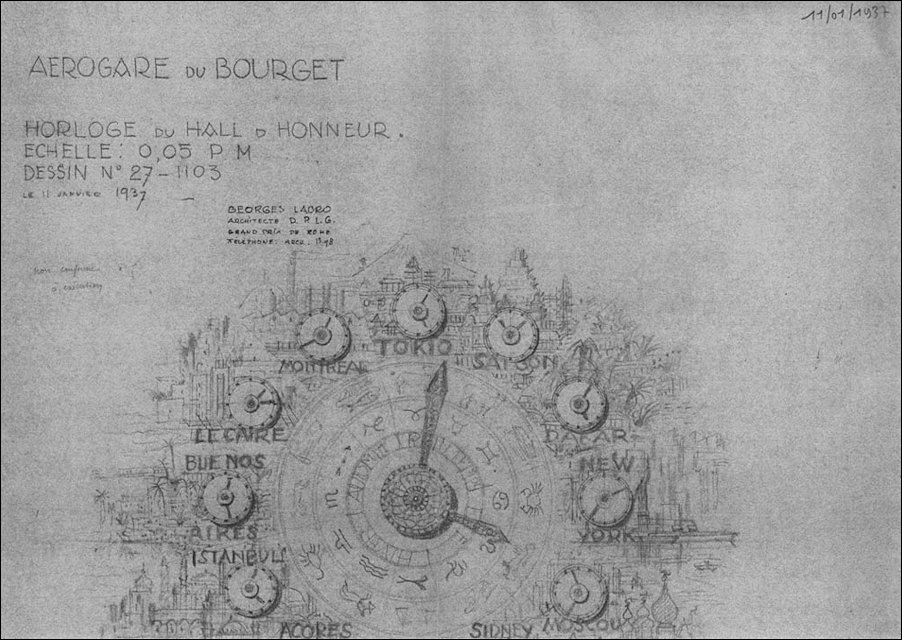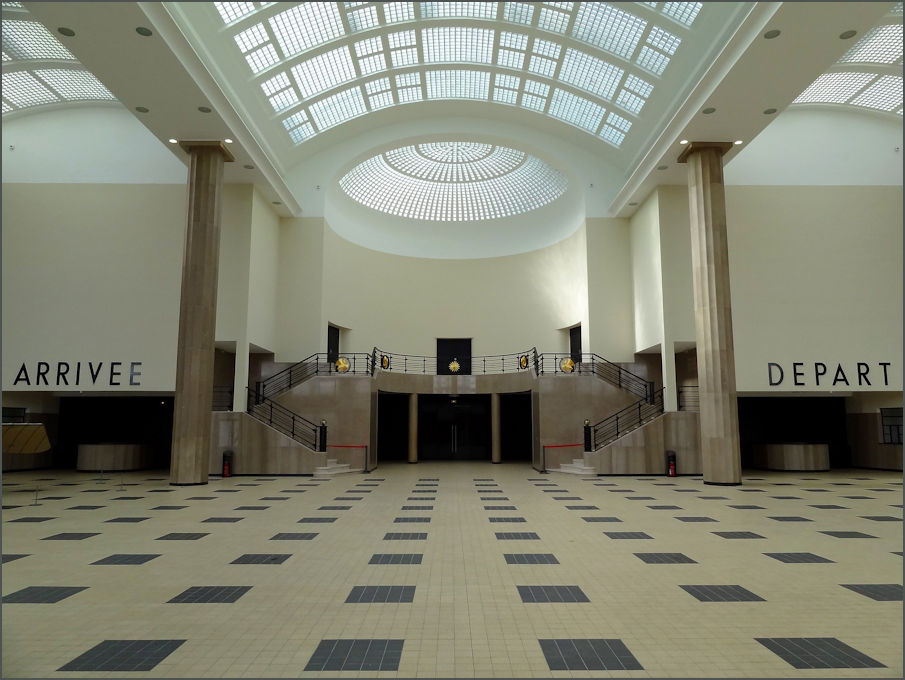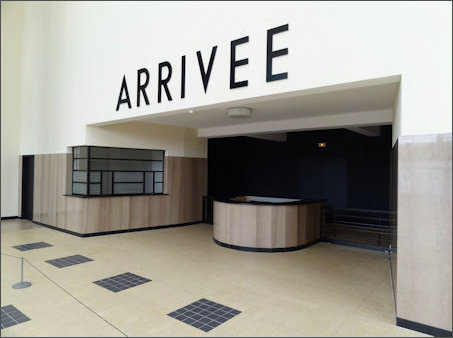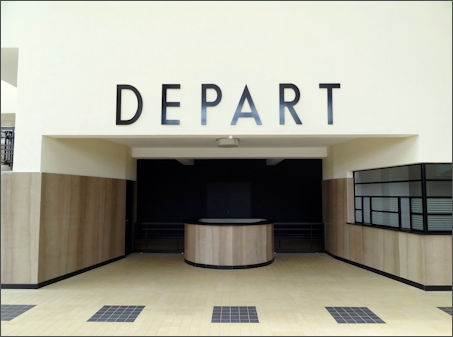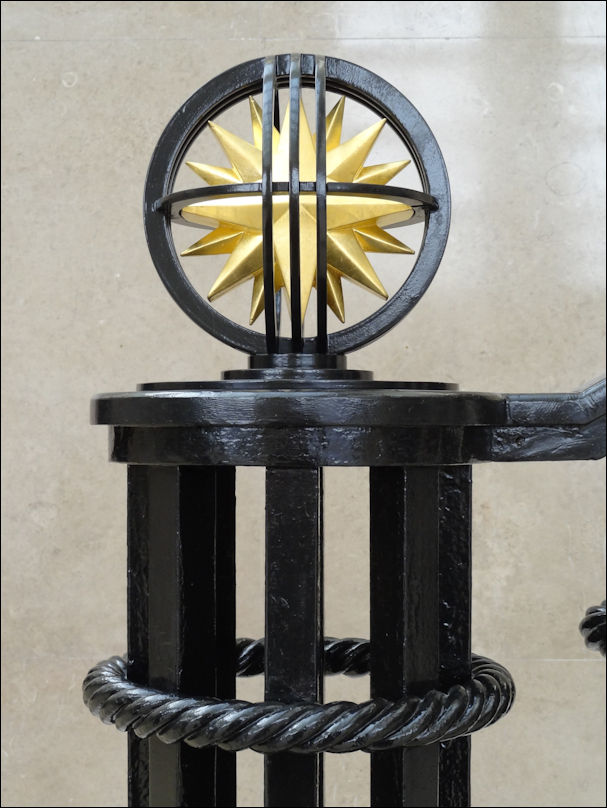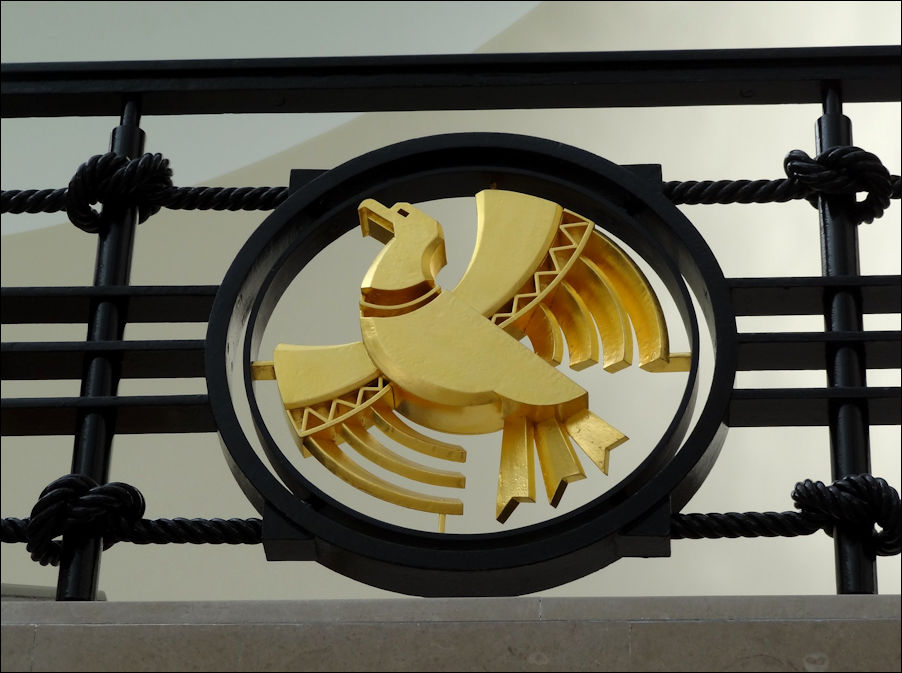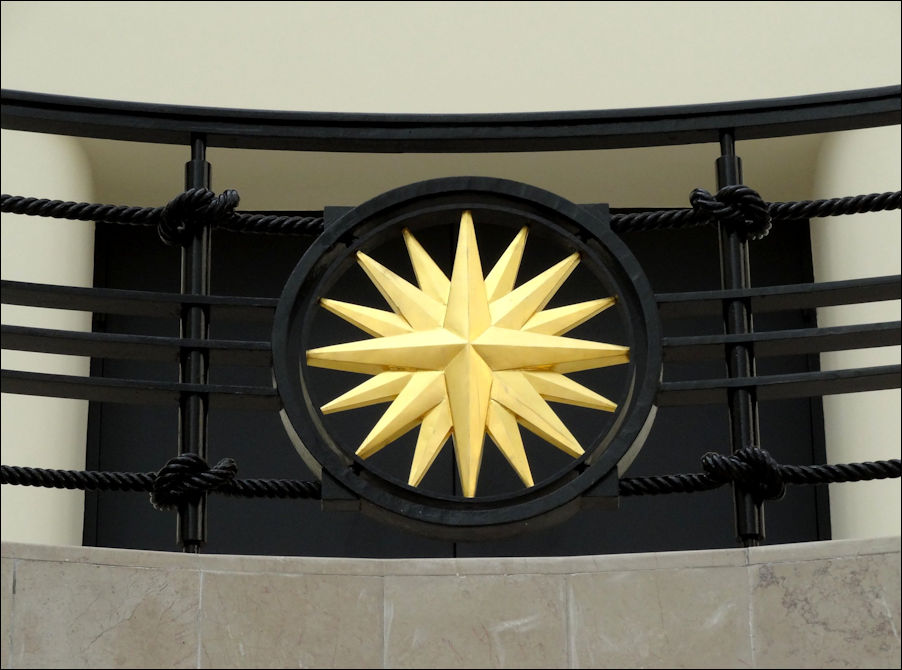Interesting Art Deco France
Home Page / Art Deco Home / Additional Information / France / Kraków / UK / US / World / Derelict
1937 - Le Bourget Airport, Paris
Paris-Le Bourget Airport celebrated its centenary in 2014. Needless to say, it is an airport with both a vast and rich cultural heritage. On the 9th October 1914, Captain Lucca landed for the first time on Le Bourget soil when he was looking for a suitable place for defending the city of Paris against the enemy. Paris-Le Bourget Airport was officially opened 5 years later in 1919 and in 1927 Charles Lindbergh landed there in "Spirit of Saint Louis", after having flown across the Atlantic. He was greeted by 200,000 people overawed by this feat, which at the time was a real achievement. In 1981, Paris-Le Bourget Airport based its activity primarily on business aviation to tackle the meteoric rise of the Paris-Orly and Paris-Roissy Charles de Gaulle Airports, and in so doing is now the leading business airport in Europe. Source : parisaeroport.fr
Le Bourget Airport in Paris
The Aeroport de Paris-Le Bourget is the oldest airport in Paris that is now one of the most active airports in Europe, yet is famous for the first transatlantic flight of Charles Lindbergh and is now home to the museum in Paris dedicated to aviation and the Paris Air Show.
Historic Lindbergh Flight lands at Le Bourget
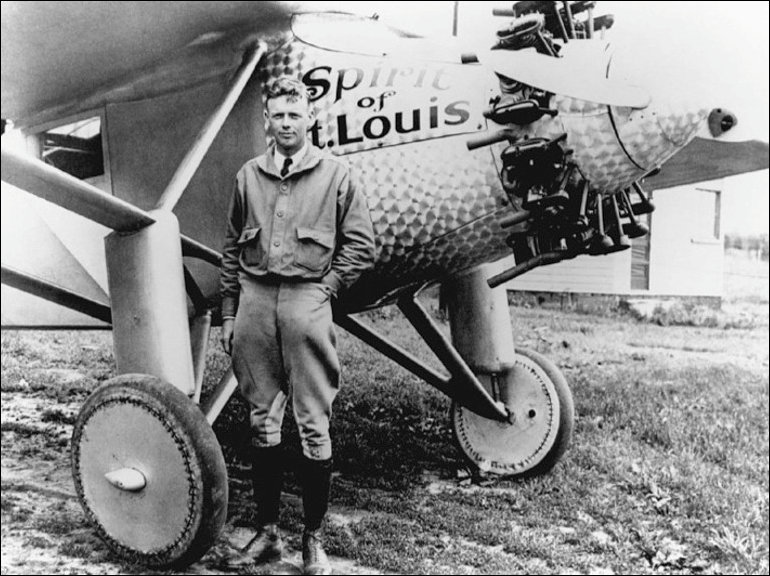
Pioneering aviator Charles Lindbergh, photographed alongside the 'Spirit of St. Louis' - image sourced from and © of Bettman/Getty images
1927 Charles Lindbergh aboard the Spirit of Saint Louis makes the first solo crossing of the Atlantic Ocean from New York and lands at Le Bourget.
A pioneering flight: Charles Lindbergh's transatlantic crossing
In May 1927, 25-year-old Charles Lindbergh became the first person to make a nonstop solo flight across the Atlantic Ocean, soaring from New York to Paris and capturing the imaginations of people all over the world.
On the morning of 20 May 1927, a little-known pilot named Charles Lindbergh waited to take off from Roosevelt Field in Long Island, New York. The 25-year-old had never flown over water before, yet 33 hours later, his single-engine monoplane, the Spirit of St. Louis, would touch down in Paris, making Lindbergh one of the most famous aviators of all time. While two British pilots, John Alcock and Arthur Whitten Brown, had made the first nonstop transatlantic flight in 1919, Lindbergh was the first person to complete this feat while flying solo, while his was also the first nonstop flight between New York and Paris.
In 1919, the challenge to become the first to fly solo across the Atlantic had been bolstered by Raymond Orteig, the French owner of a New York hotel. Fascinated by the travel and advancement opportunities offered by aviation, Orteig promised $25,000 to "the first aviator of any Allied country crossing the Atlantic in one flight, from Paris to New York or New York to Paris". The Orteig Prize, as it became known, was initially intended to run for five years, but when 1924 arrived with the money still unclaimed it was renewed for another five-year period. Despite the prize money on offer, it was a passion for aviation that drove Lindbergh, writes author Dan Hampton in his new book The Flight, a pilot's-eye-view of the journey: "Charles Lindbergh believed in the power of aviation: its untapped potential and inherent capacity to join peoples, advance technology and bring the world closer together". Author Hampton describes Lindbergh as "a complicated man and, in later years, a controversial one" – an acknowledgment of Lindbergh's mixed legacy in the years following his momentous flight. In 1932, the aviator found himself in the spotlight once more, following the tragic death of his 20-month-old son during a kidnapping dubbed "the crime of the century", and in later years, Lindbergh also made headlines for his high-profile opposition to US involvement in the Second World War and well-documented anti-Semitism and fascist sympathies. Yet back in 1927, Lindbergh's accomplishment saw him become one of the most famous people in the world overnight. While only 500 people showed up to see the aviator depart from New York on 20 May, upon his arrival in Paris on 21 May he was mobbed by a crowd of more than 100,000 people. Read more here:
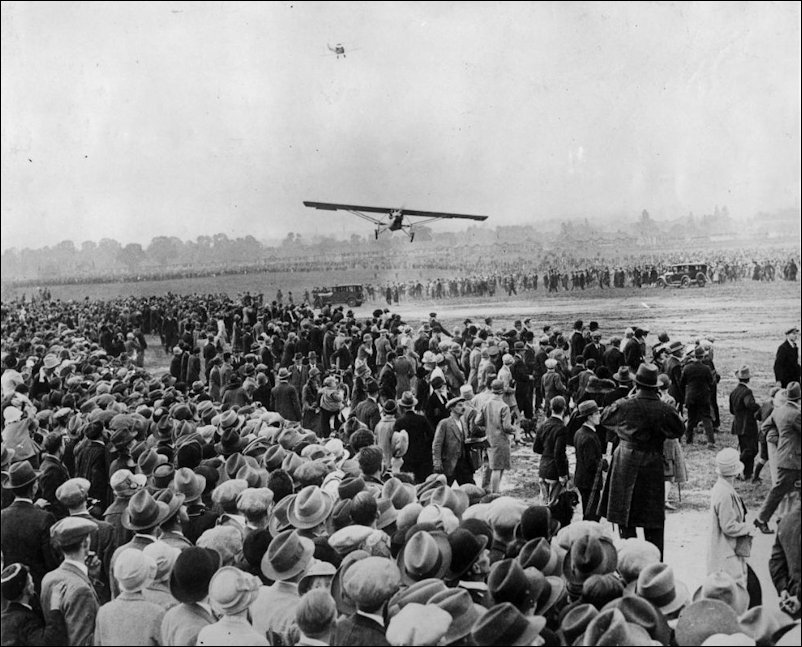
Lindbergh about to be mobbed by over 100,000 people in Paris as he makes his successful landing - image sourced from vintagenewsdaily.com with thanks
The beginnings of Le Bourget Airport in Paris
With an official name of Aeroport de Paris-Le Bourget the land for the airport was originally acquisitioned for military purposes for World War I, and many famous pilots performed their missions from Le Bourget Airport, which at the time was the main military base. However, after World War I some of the facilities were reverted to civil aviation and the first airport in Paris started commercial operation in 1919 with business flights between Paris and London and Paris and Brussels.
In 1927 a biplane had taken off from here in an attempt to do a transatlantic flight, but unfortunately disappeared, yet only two week later, the Le Bourget Airport became famous as the landing site for the historical solo flight of Charles Lindbergh who successfully arrived on the transatlantic flight from New York to Paris. But it was in 1930 that saw the first successful transatlantic flight from Paris to New York by the pilots Dieudonne Costes and Maurice Bellonte, and then the Orly airport in Paris was opened in 1932 to support Le Bourget with its increased traffic.
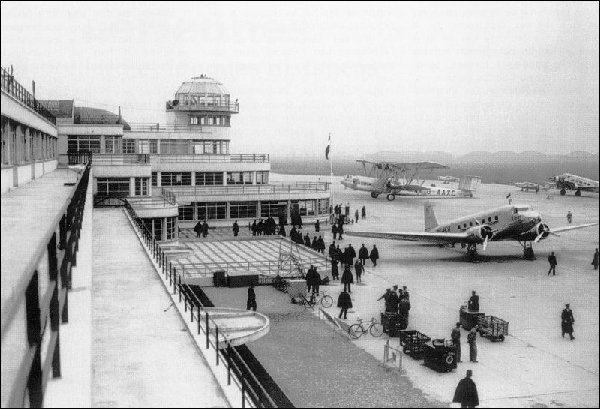
1937 Inauguration of the terminal building - image sourced from abccorporate-aviation with thanks
Yet it was only a few years later in 1937 and in conjunction with the World Fair in Paris that a new terminal was constructed, which was designed by the architect Georges Labro and the inauguration took place at the Universal Exhibition in the presence of the French Present Albert Lebrun.
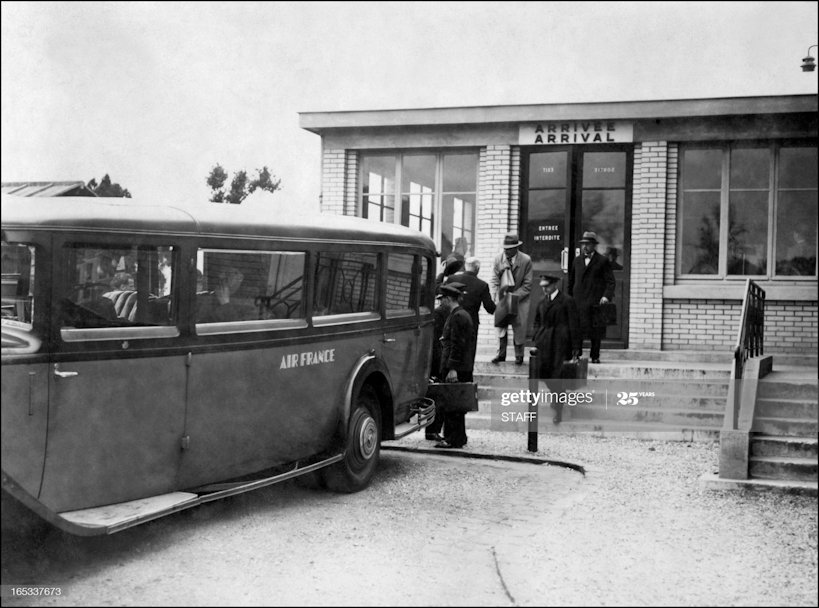
If you were attending the inauguration of the terminal you'd likely arrive in an aeoroport limo like the one shown above. "Passengers are to go up into Air France car, 15 May 1936, upon their arrival at Le Bourget airport. A new International airport of Le Bourget will be inaugurated 15 November 1937." Photo credit and strapline courtesy of STAFF/AFP via Getty Images
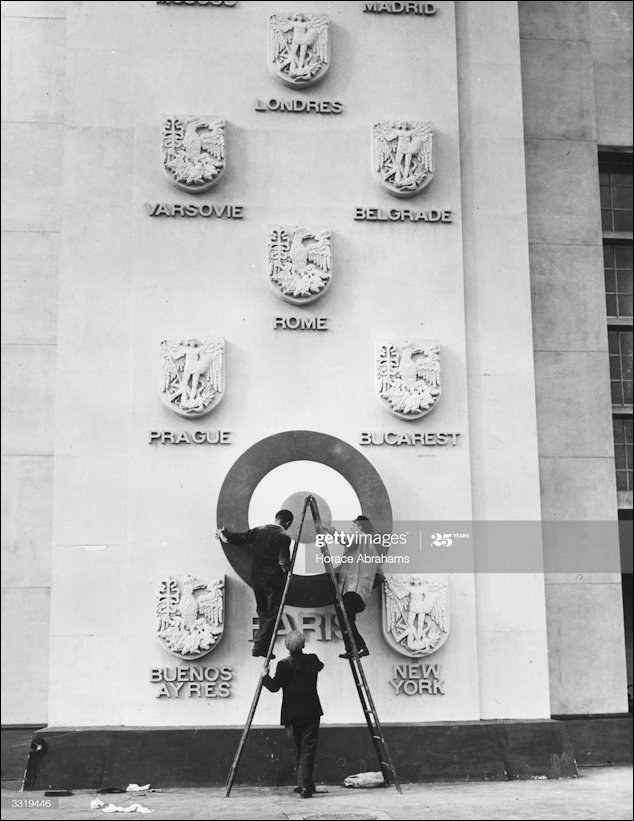
"Coats of Arms - 12th November 1937: Workmen fixing coat of arms of all the capitals of the world outside the Le Bourget Airport, near Paris." Photo credit and strapline courtesy of - Photo by Horace Abrahams/Fox Photos/Getty Images
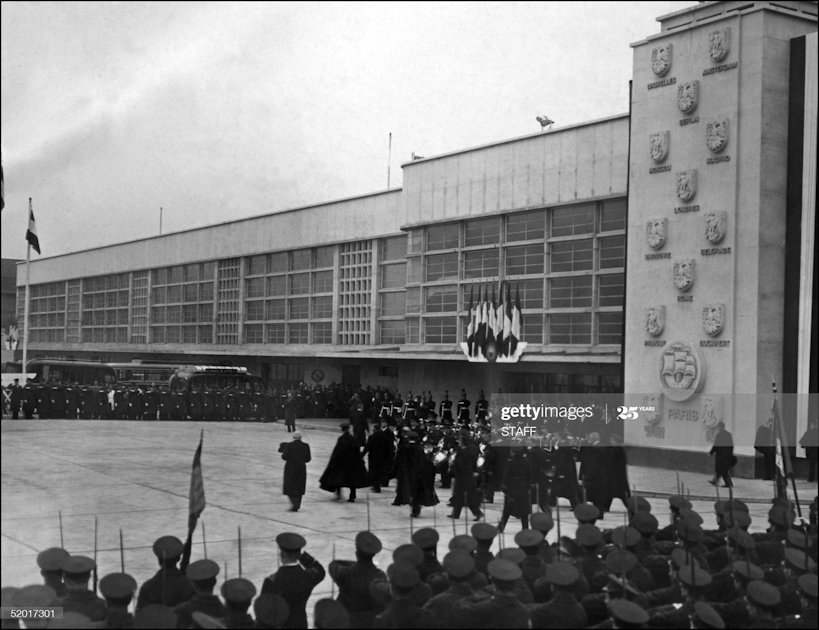
Opening Day at Le Bourget Airport | "Flags from many nations hang in Le Bourget on its opening day in 1937. French President Lebrun opened the airport." Image and strapline courtesy & © of - Photo by © Hulton-Deutsch Collection/CORBIS/Corbis via Getty Images
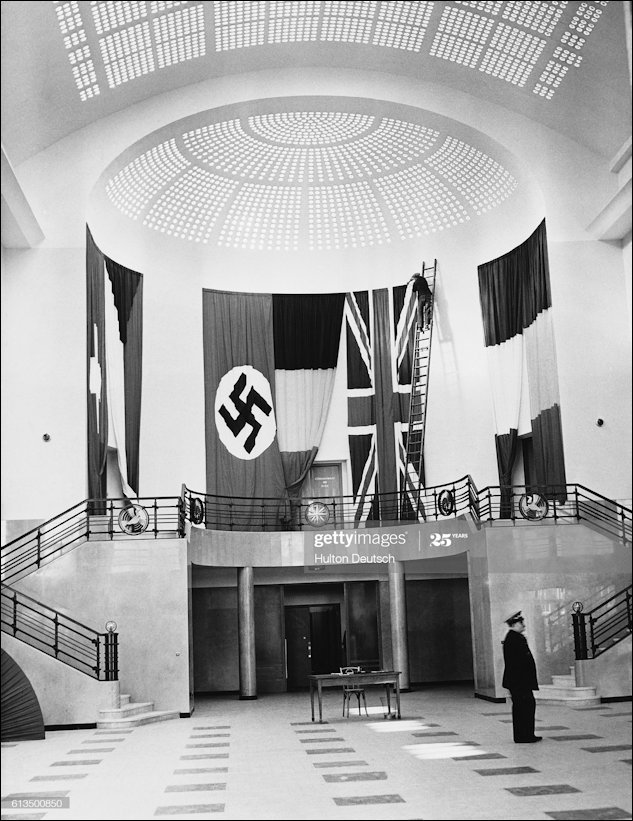
Officials inaugure the new International airport - "LE BOURGET, FRANCE - NOVEMBER 15: Officials inaugure the new International airport of Le Bourget, 15 November 1937." Image and strapline courtesy and © of - Photo credit should read STAFF/AFP via Getty Images)
Le Bourget in World War II through to the present
However, when World War II broke out and Paris became occupied by the Germans, the Aeroport de Paris-Le Bourget was also taken over and at this time they constructed new concrete runways. And in fact, in 1940 Adolf Hitler landed here to start his only tour of Paris, but as you can no doubt imagine, this airport was bombed on many different occasions during the war. Yet it was eventually restored after the liberation of Paris in 1944 and from the May of 1945 there were around 42,000 prisoners of war that were repatriated through Le Bourget airport.
After World War II had come to an end, air traffic increased rapidly, especially in the civil aviation arena and by 1952 the city of Paris decided to adopt Orly as the main airport for Paris. And so, from 1953 Le Bourget was to become the site that hosts the Salon International de l'Aeronautique et de l'Espace - Paris Le Bourget or the Paris Air Show as it is also known, which is held every other year and is now the largest aviation show of its kind in the world. But by the 1960s the Orly airport was becoming over saturated with the number of flights and this resulted in the Bourget airport being utilised for commercial flights and business flights once again. Yet by the start of the 1970s flights had increased substantially and even the two Paris airports could not cope with the demand and it was decided that a new airport had to be constructed, so by 1973 the Roissy-en-France airport, which is now known as the Charles de Gaulle airport, was put into operation.
Also the Musee de l'Air et de l'Espace museum was moved to the Aeroport de Paris-Le Bourget in the same year that the Charles de Gaulle airport opened, and being the oldest aviation museum in the world, it still remains here today. However, with the disappearance of commercial traffic in 1977 Le Bourget converted to business needs of the aviation industry and has now become one of the most active airports in Europe, and this does mean that there are still flights available to this airport from many different destinations. Source : eurotouring
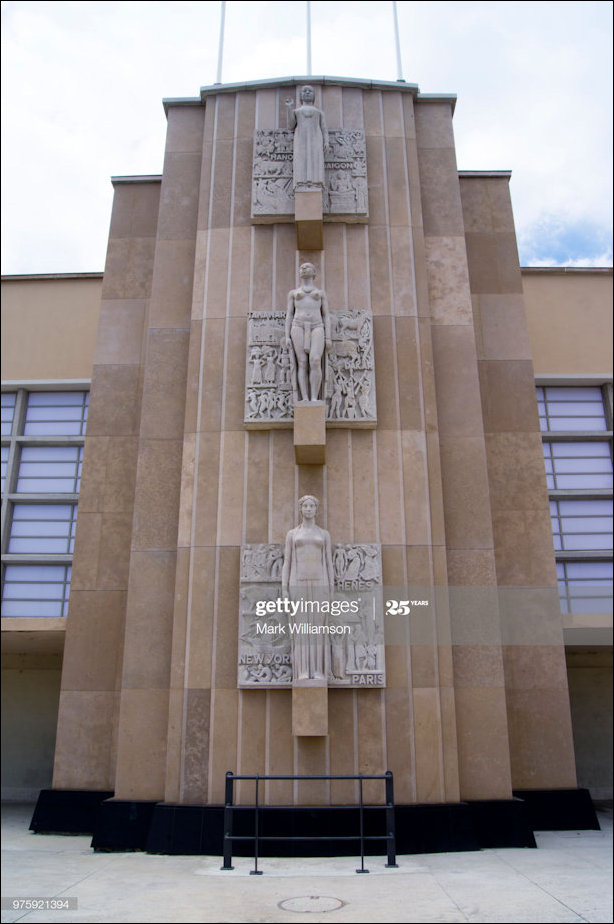
Le Bourget airport terminal facade - A detail of the façade of the main terminal building of the former Le Bourget airport to the north-east of Paris, France. The building dates from the 1930s and was designed by architect Georges Labro in the Art Deco style. Image sourced from picuki.com
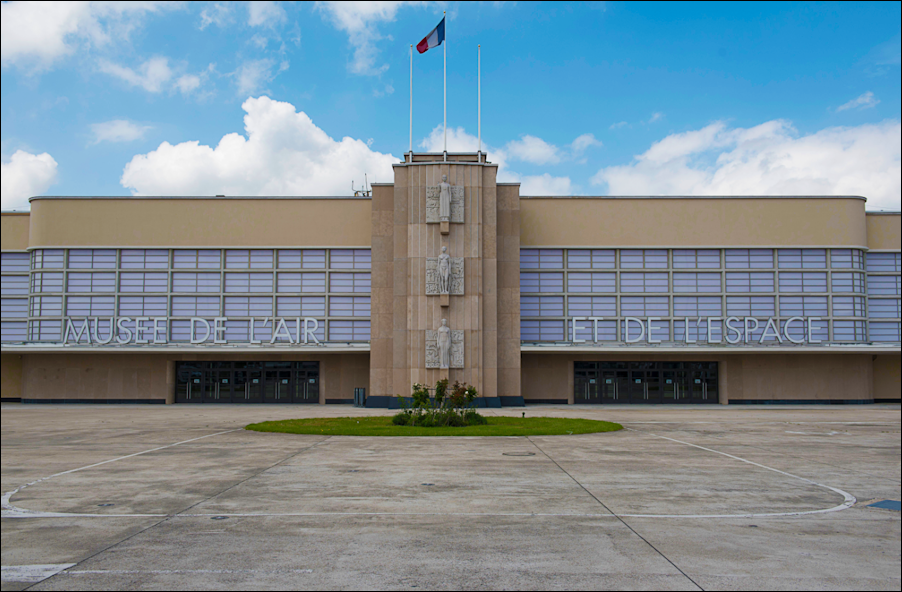
The entrance to the former Airport now converted to the 'Air & Space Museum' (Musée de l’Air et de l’Espace)
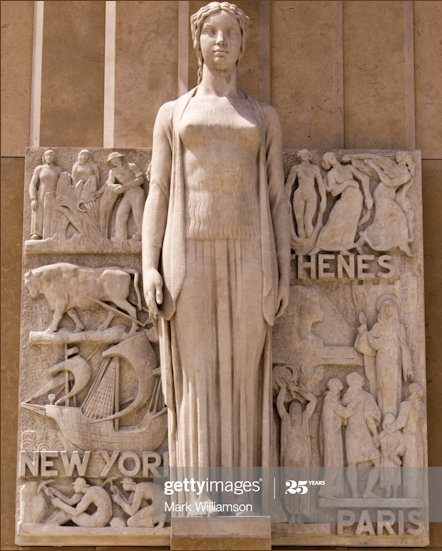
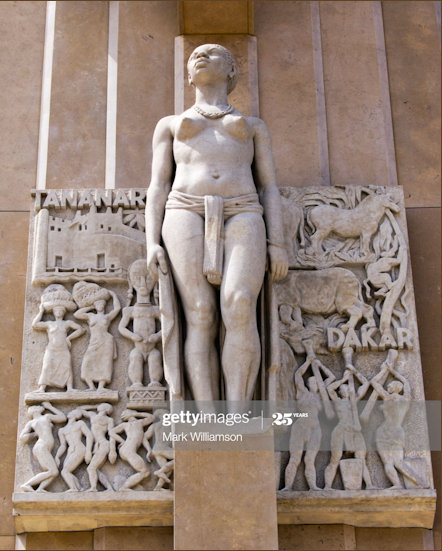
Two of the Muses representing (l to r) Europe/USA and Africa/Middle East/Madagascar respectively, the top figure features Hanoi and Saigon in her sculpture which is representative of the Far East making this a truly International and Global Airport in its day - images sourced from & © of Getty Images
As a bond between past and future, the prestigious Air and Space museum is a lively place, holding events all year round, regularly acquiring collection objects, providing entertainment for all. It also offers rental spaces for events and filming. The place the Air and Space museum has been built on is very important and full of memory. Le Bourget is a place that has seen many aviation heroes, and among them, Charles Lindbergh. Furthermore it is the birthplace of commercial aviation; buildings are of great cultural interest, like the Art Deco terminal building. Source : Musée de l’Air et de l’Espace
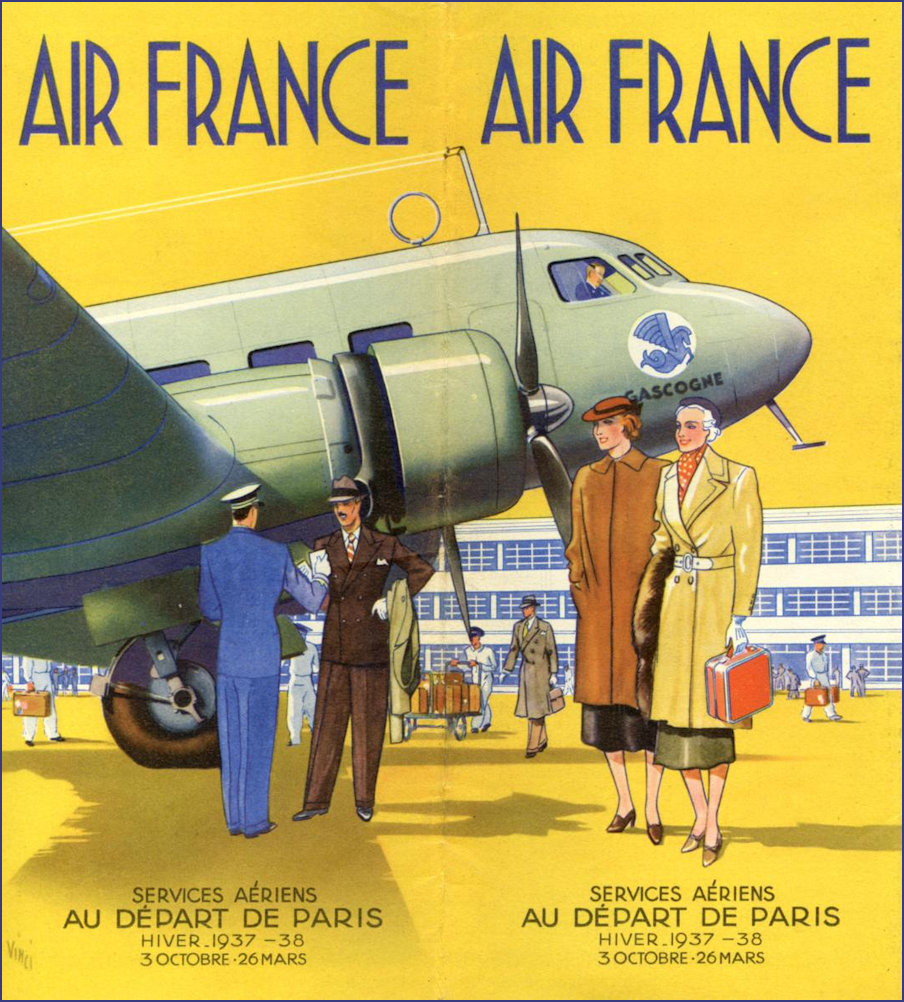
The Winter Departure Flights Poster for the 1937-8 season - what an excellent piece of history - image sourced from 'A Year of Aviation Illustration & Art'
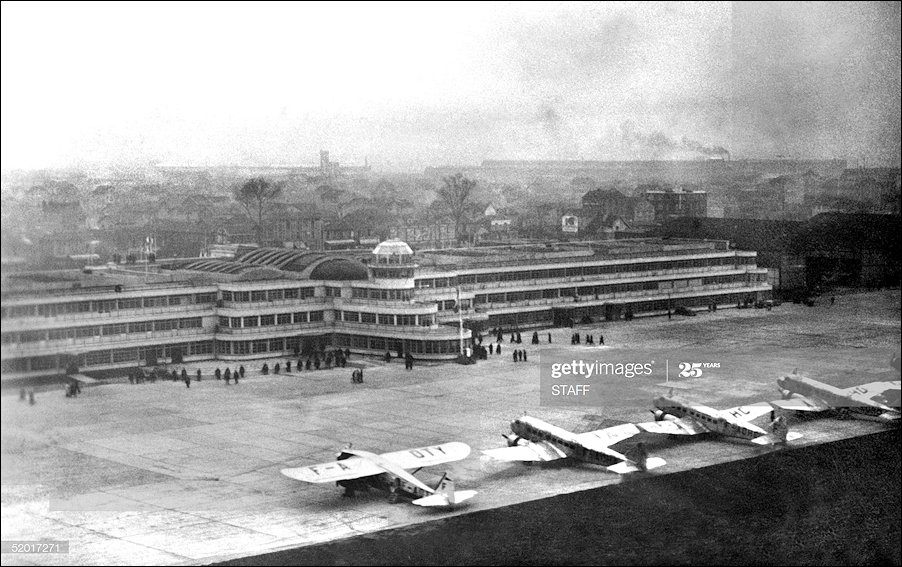
Aerial view of the new International airport of Le Bourget, 17 November 1937, that was inaugurated 12 November 1937. / AFP PHOTO / STAFF (Photo credit should read STAFF/AFP via Getty Images)
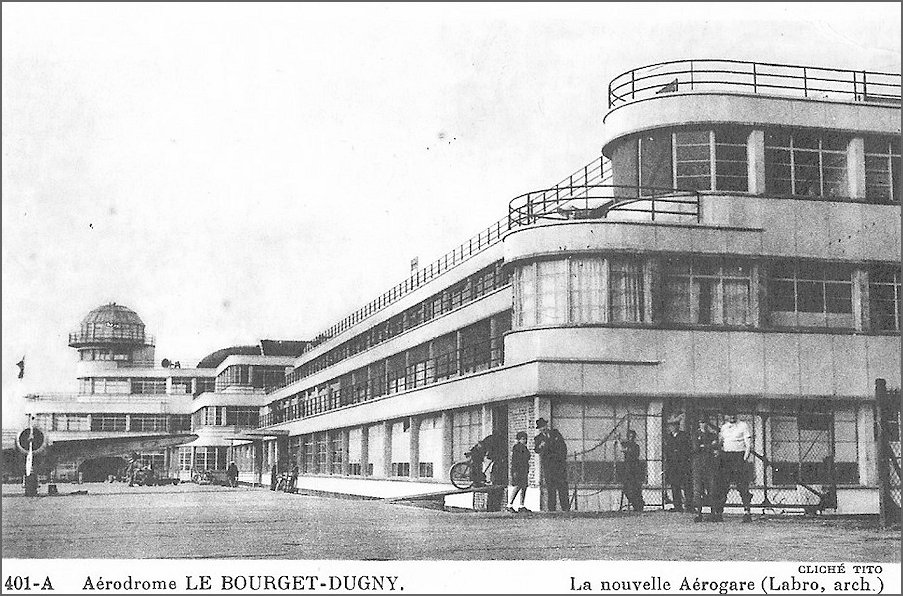
Image sourced from Aerofossile2012 via Flickr
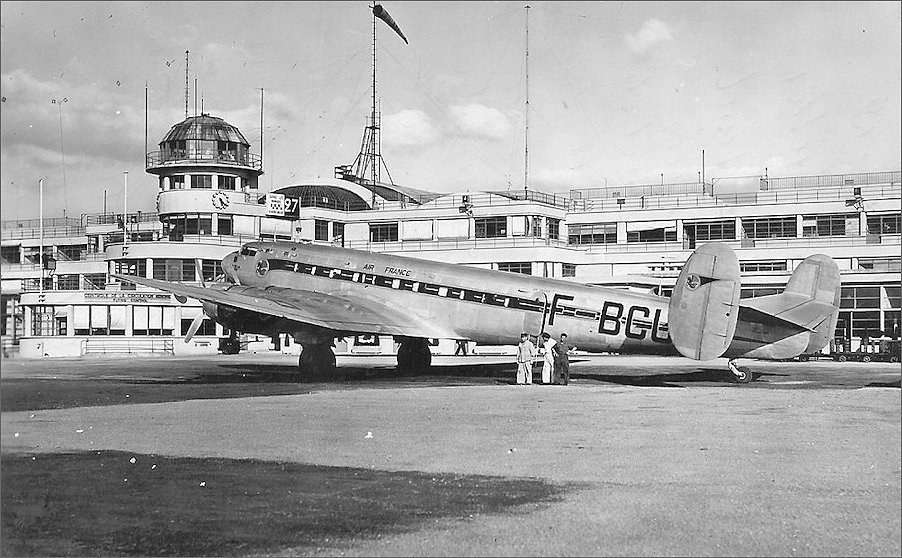
With the Control Tower and empty viewing gallery in the background an Air France aeroplane has taxied into position - it is the SNCASE SE.161 Languedoc - image sourced from Airfossile2012 via Flickr
The SNCASE SE.161 Languedoc was a French four-engined airliner produced by SNCASE. Developed from the Bloch MB.160 and known in the late 1930s as the Bloch MB.161, the SE.161 was in service with Air France and the French military after World War II.
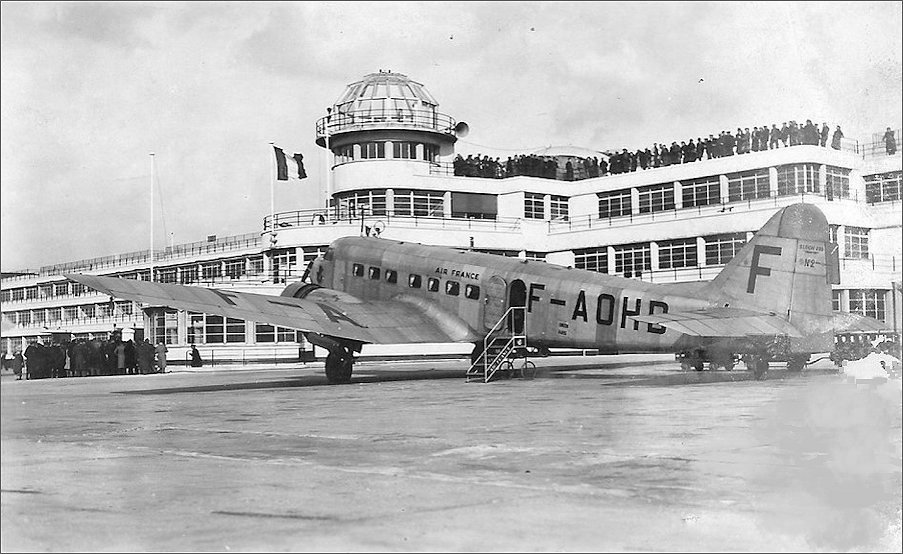
In front of a huge crowd on the viewing platform the Air France Bloch 220 'Auverne' has just disembarked its Passengers - image sourced from Airfossile2012 via Flickr
The Bloch MB.220 was a twin-engine transport aircraft built by the Marcel Bloch aircraft company making its maiden flight on June 11, 1936 at Villacoublay. Its design was largely inspired by the Douglas DC-2 with an all-metal coating, a low cantilever wing with a leading edge in a slight arrow and trailing edge perpendicular to the reference axis. Its crew consisted of two pilots and two stewards for a capacity of 16 passengers. Air France ordered a fleet of 16, giving each aircraft the name of a province: Alsace, Anjou, Aunis, Auvergne, Berry, Champagne, Flandre, Gascogne, Guyenne, Languedoc, Lorraine, Poitou, Provence, Roussillon, Saintonge and Savoie. The first machines were delivered in 1937 and used on the Paris - Marseille line making their first scheduled flights on July 20, 1937.
The MB 220 is much more comfortable than other aircraft in service in 1936: Pullman armchairs with adjustable backrests, shelf designed with a hole to accommodate a cup, soundproofing, heating and ventilation. (Everything we take for granted today of course!) Passengers were served by a crew of three or four members depending on the line, the passenger capacity of the aircraft being sixteen people. In addition to its regular commercial services, the MB.220 is used by the French government for official travel. It was the "MB.220 Poitou" used by the President of the Council, Edouard Daladier, when went to meet Hitler to sign the Munich agreement on 28th September,1938. When war was declared in September 1939, all of the MB 220s built (i.e. the prototype and the sixteen serial models) were requisitioned by the Air Force. In 1940, several planes were seized by the Germans and entrusted to the Lufthansa. Used in France until the early 1950s, the aircraft were re-engineered with Wright Cyclone engines and renamed MB 221. Four aircraft are used by the Air Navigation Auxiliary (SANA).
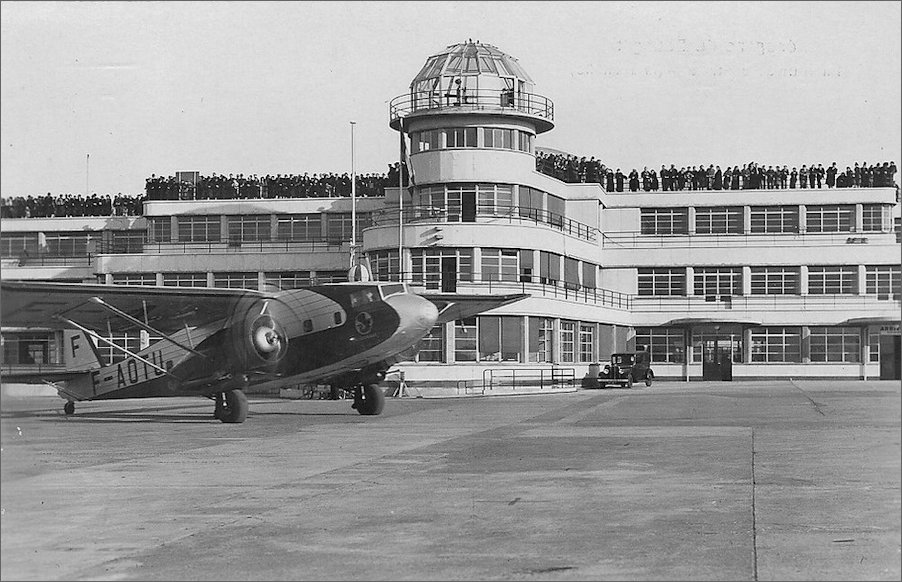
A Potez 62 taking off from just outside the Control Tower at Le Bourget - image sourced from Airfossile2012 via Flickr
Potez 62 was a French twin-engine civil airliner, designed in 1934 by Henry Potez who was a French aircraft industrialist. He studied in the French Aeronautics School Supaéro. With Marcel Dassault, he was the inventor of the Potez-Bloch propeller which, after 1917, was used on most of the Allied planes of World War I.
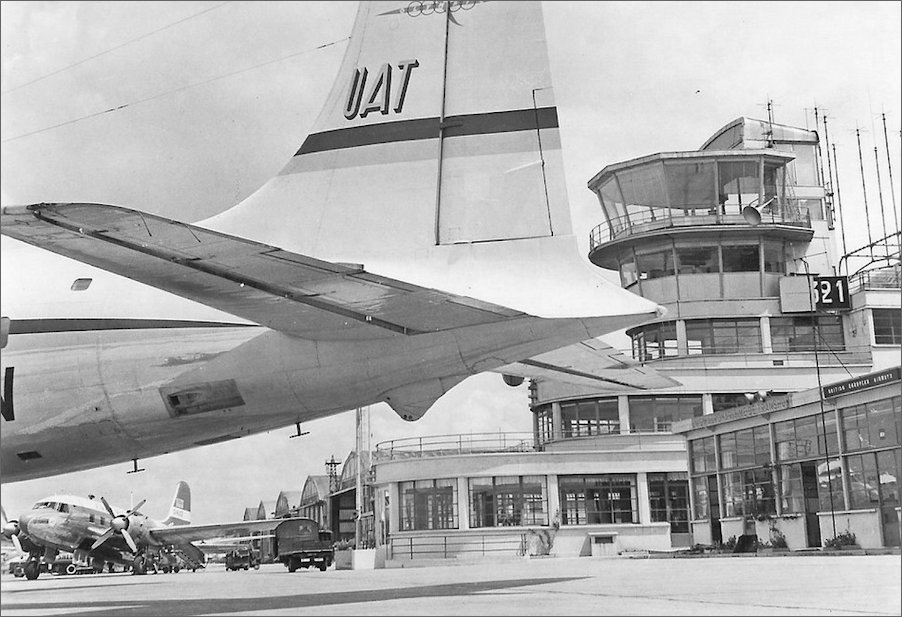
Regrettably the 'iconic' and it was iconic Control Tower was replaced by the more familiar shape of the 1960s and 70s which was an appalling time for innovative architecture - image sourced from Airfossile2012 via Flickr
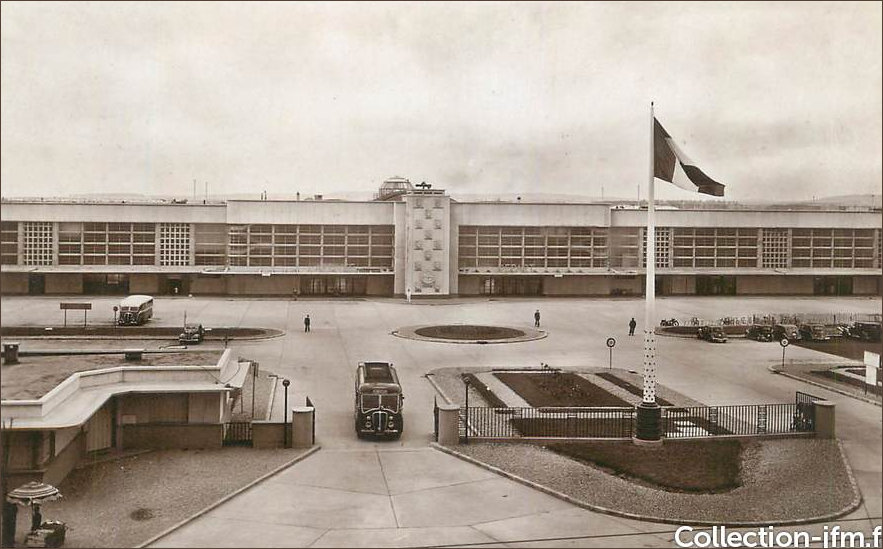
Exit gates with the 'heraldic sculptures in the background
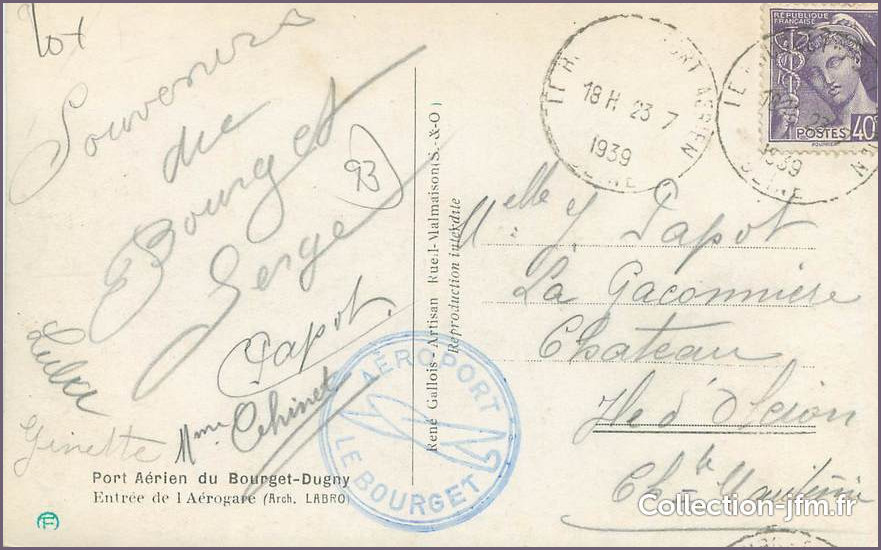
A postcard posted in 1939 with special Airport frank in addition to the postal date stamp giving its historical provenance - images sourced from : collection-jfm.fr
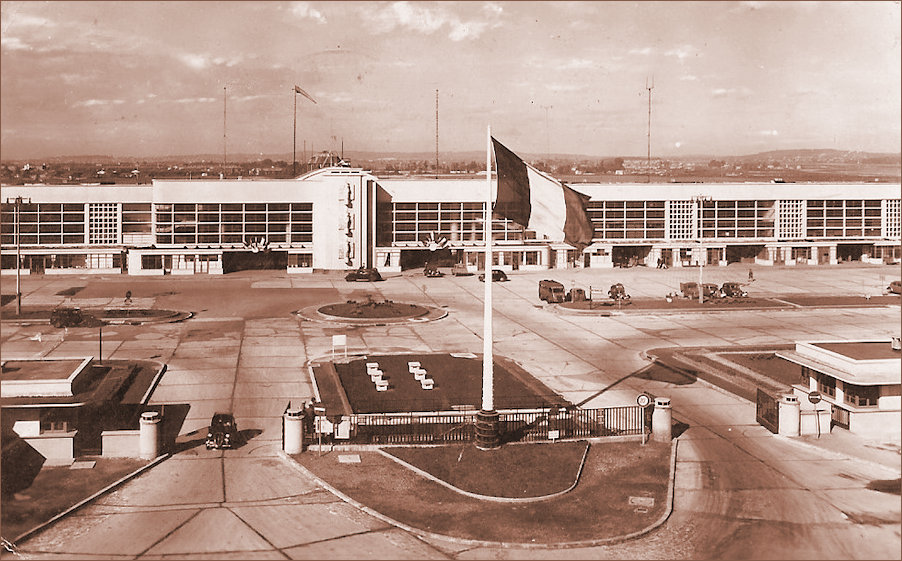
Alternative exit gates with the Muses in the background - image sourced from Aerofossile2012 via Flickr
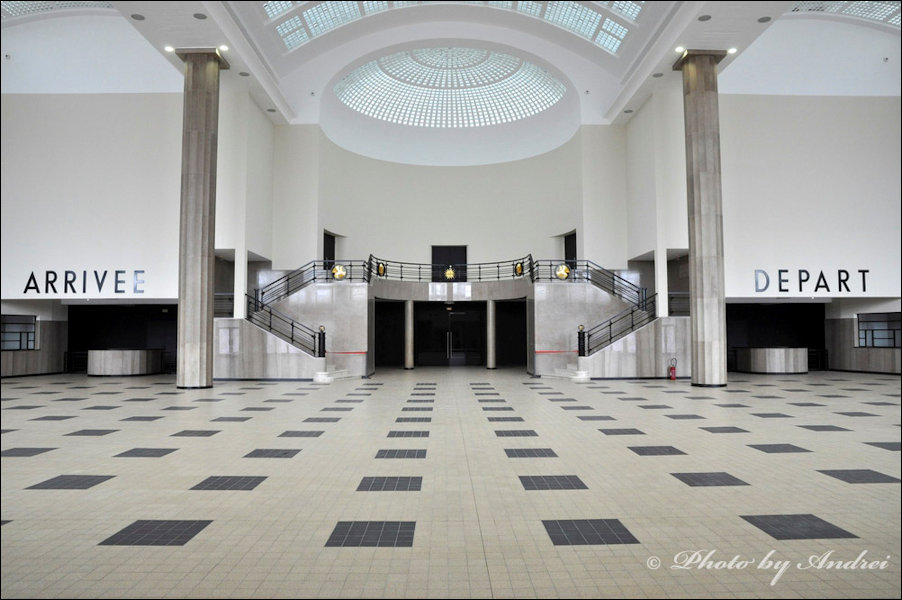
Arrival and Departure Lounge as it would have looked on opening day in 1937 - image courtesy & © of Andrei (2013)
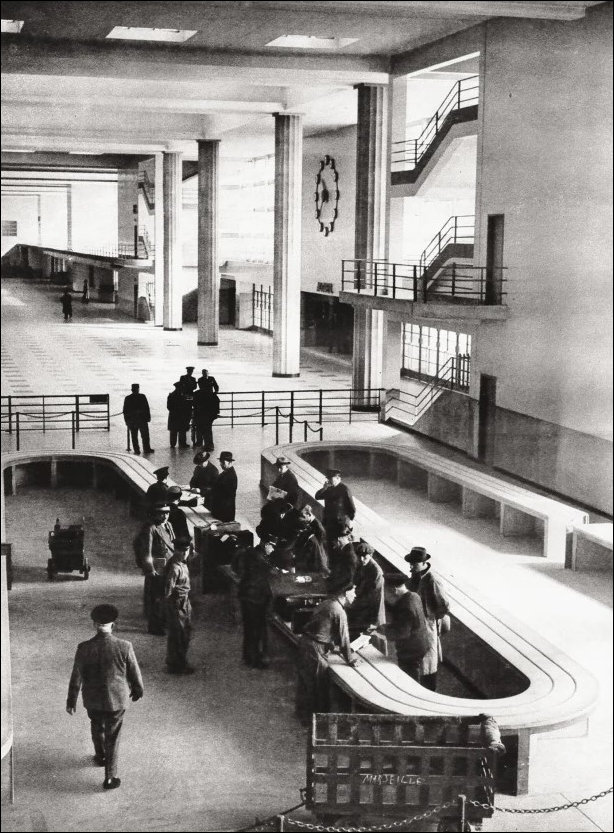
A very active looking Customs Area cordoned off and guarded - image sourced from : afr.com via Pinterest
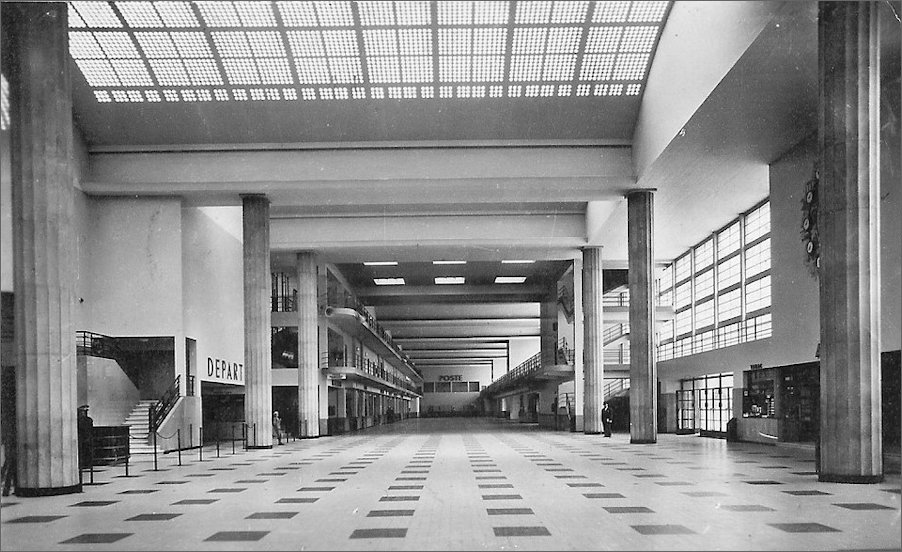
The full length of the interior thoroughfare with the Destination Clock visible on the right opposite the intricate stairwell - image sourced from Aerofossile2012 via Flickr
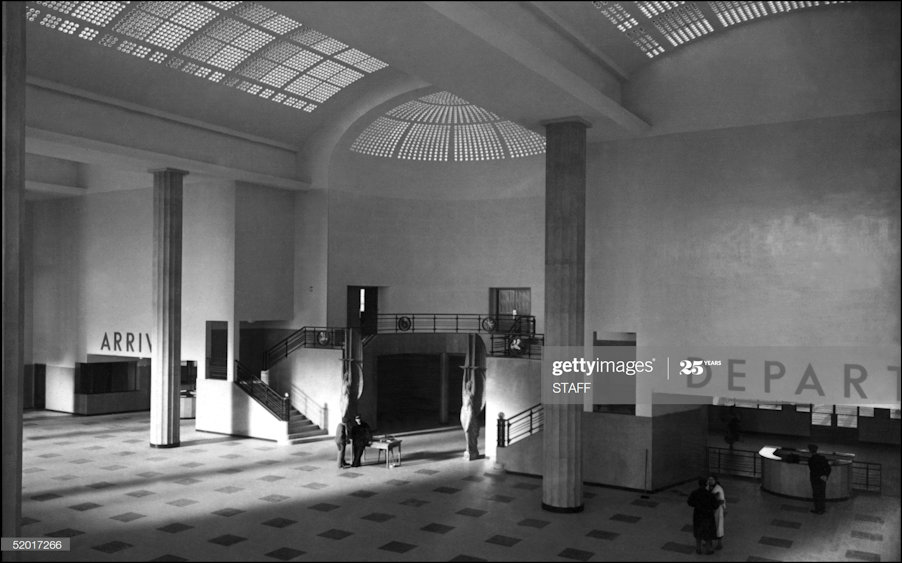
Partial view of departure and arrival hall - LE BOURGET, FRANCE - NOVEMBER 6: Partial view of departure and arrival hall of the new International airport of Le Bourget, 06 November 1937, that will be inaugurated 15 November 1937. (Photo credit should read STAFF/AFP via Getty Images)
The Clocks (L'horloges) of Le Bourget
In the 'Salle aux huit colonnes' (Hall of 8 Colonnades)
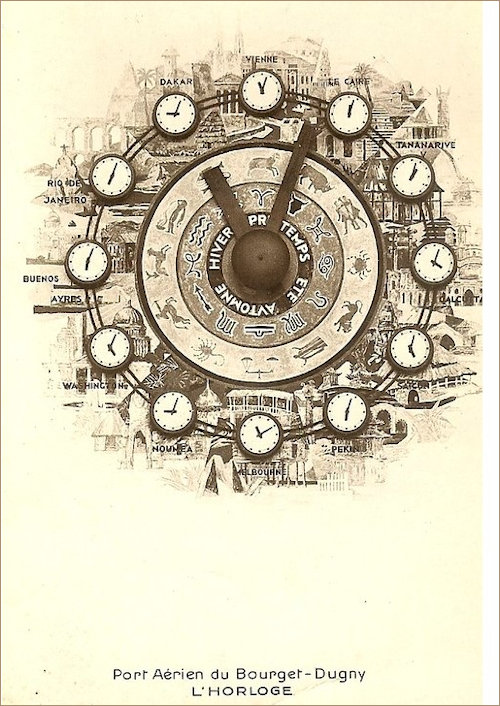
Image sourced from Aerofossile2012 via Flickr
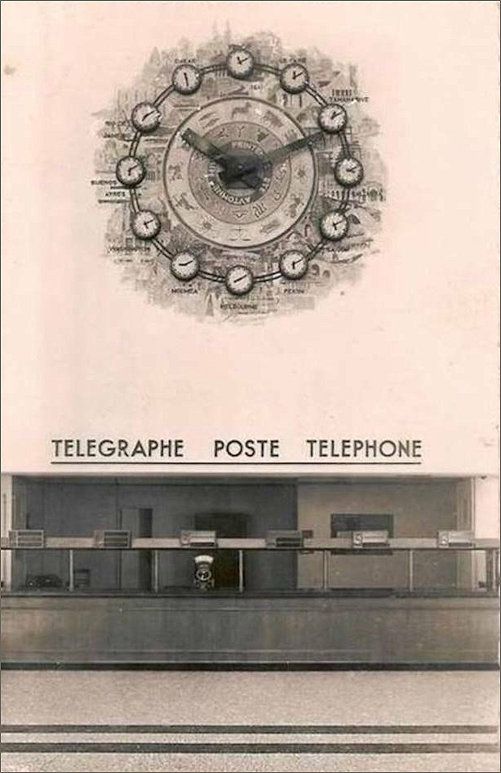
The Clock on the wall above the Tabac and Information Wings with Post Office Counters clearly visible (were these temporary structures that were moved when not required? - Remarkable image sourced from ebay.fr
A thing of supreme beauty, a sketch of the Reception Clock described a 'This architectural gem, dating from 1937, has been restored to its original state (the original fresco painted on the clock will be produced in a second phase) and was reopened to the public in June 2013, in the salon du air and space museum.' by Le Nuancier DS
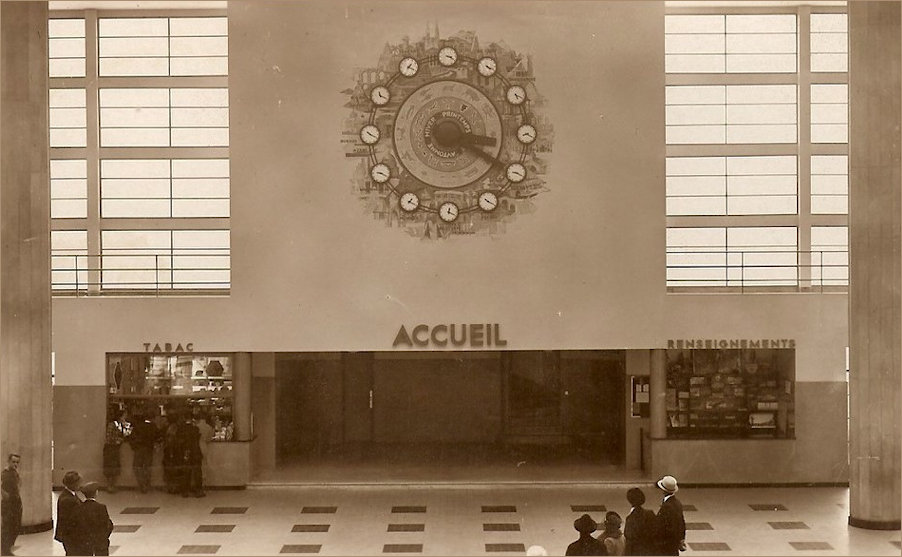
The clock overshadows the Reception (Accueil) Area which is flanked by the Tabac (Tobacco) and Information (Renseignements) stalls - image sourced from Aerofossile2012 via Flickr
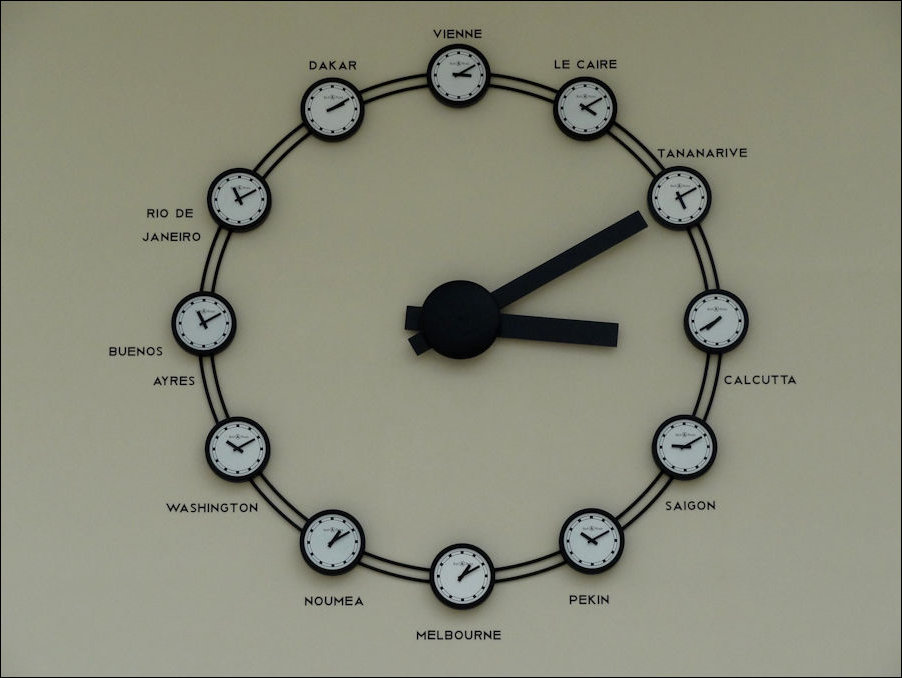
A fabulous Clock showing (like the external Muses) all the destinations this airport catered for way back in 1937 - for those who don't know or recognise a couple of the names (and I didn't!) - Tananarive is the capital of Madagascar and Noumea is the capital of New Caledonia.
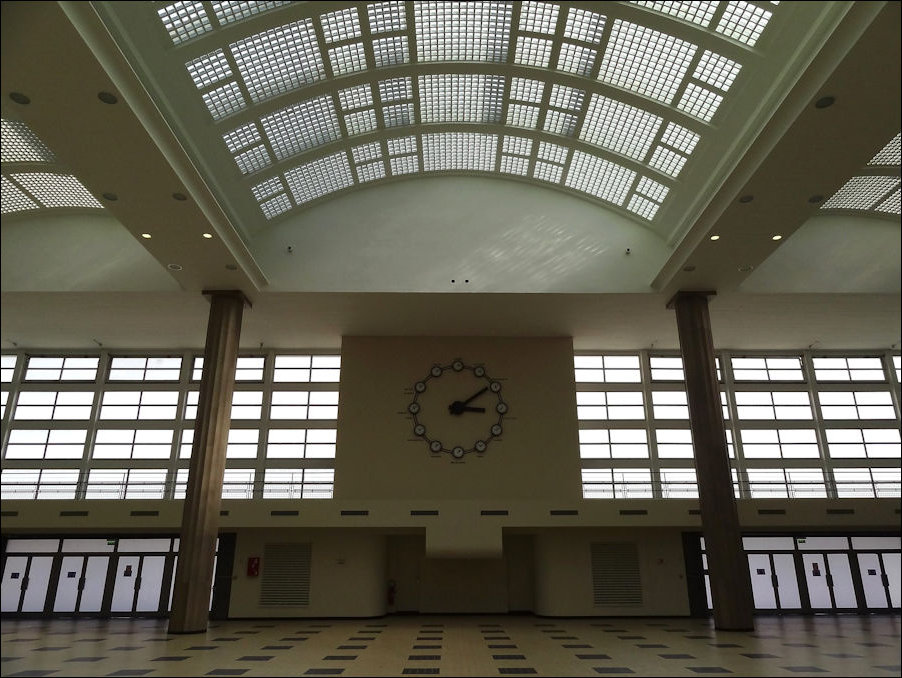
The remarkable 'destination' clock is housed in the grandly named (and almost sounding Napoleonic) 'Hall of Eight Colonnades' - both images sourced from Oméga via Flickr
The Design & Artwork of the Stairwell
Here is the full panoramic view of the Stairwell flanked by the Arrival and Departure Halls
With more than a nod to 'The Sun King' the stairwell art is beautifully crafted wrought iron - all images sourced from Oméga via Flickr
Poirot @ 'Le Bourget' - 'Death in the Clouds'
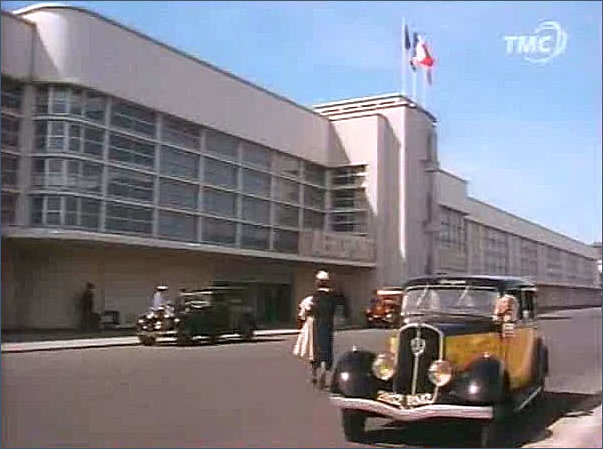
Instantly familiar to all who have studied the historical images of this airport is the entrance to former airport, now the Musée de l’Air et de l’Espace
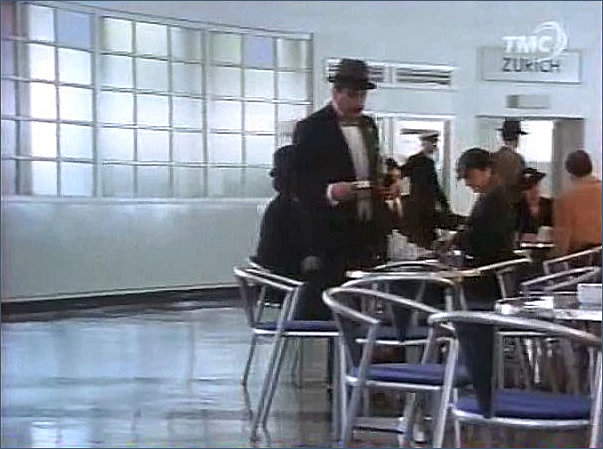
The spacious 'Salle aux huit Colonnes' converts a corner for Poirot to have a drink in the Departure Lounge whilst awaiting his departing flight from Paris - both images are television 'screen dumps' and sourced from : Architecture Art Deco
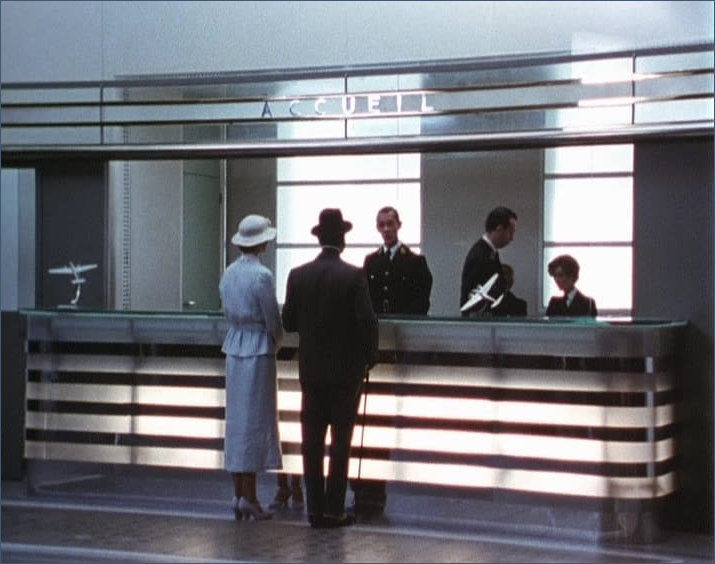
An action frame from 'Death in the Clouds' sourced from : picuki.com
'Death In the Clouds' was a bit of a departure from the usual British landscape Poirot found himself in and when not in between airports and the occasional flight, the majority of the action was set in Paris Art Deco/Moderne icons including Roland Garros Tennis Complex home of the 'French Open', Le Bourget and Shoreham Airports.
1929 - Tamara's Paris Pad
The artist Tamara de Lempicka | Born May 16 1898, Warsaw, Poland. | Died March 18 1980, Cuernavaca, Mexico. | Style and technique of the artist: Art Deco, Painting
Tamara de Lempicka is perhaps the most famous painter of the art deco period. She was born in Poland and moved to Russia where she lived until the Bolsheviks arrested her husband during the Russian revolution. She secured his release and they fled to Paris. there she learned to paint, enrolling at the Academie de la Grand Chaumiere and studying privately. Source : the-artists.org | Extended biography available at "Women In Art"
"This artist’s studio is a remarkable Art Déco testimony, and was originally occupied by the famous Polish painter Tamara de Lempicka. It resides in a building designed by the architect Robert Mallet-Stevens, along with Jean Prouvé, the Barillet workshop and André Salomon, who associated to make a total work of art. Located in the 14th arrondissement in Paris, the apartment extends over a surface of 152 m² and is composed of two floors which offer large volumes and a beautiful view on the tree-filled courtyard and on the gardens of the Covent of the Cluny Sisters. The apartment includes a 60m² artist’s studio with a 6 meters height under ceiling. The period decor was preserved, such as the stained glass windows realized by Louis Barillet’s workshop. The furniture of the smoking room on the mezzanine was also entirely preserved. The apartment also has a completely equipped dining kitchen, two bedrooms and two bathrooms. A cellar completes this exceptional property. This artist’s studio is located in the only apartment building built in Paris by Robert Mallet-Stevens." Source : architecture for sale as used in atelierblog
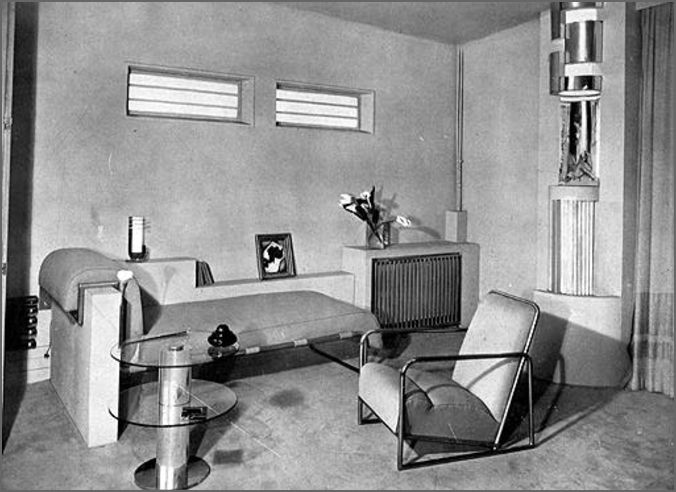
Image sourced from and courtesy of Robert Mallet-Stevens blogspot
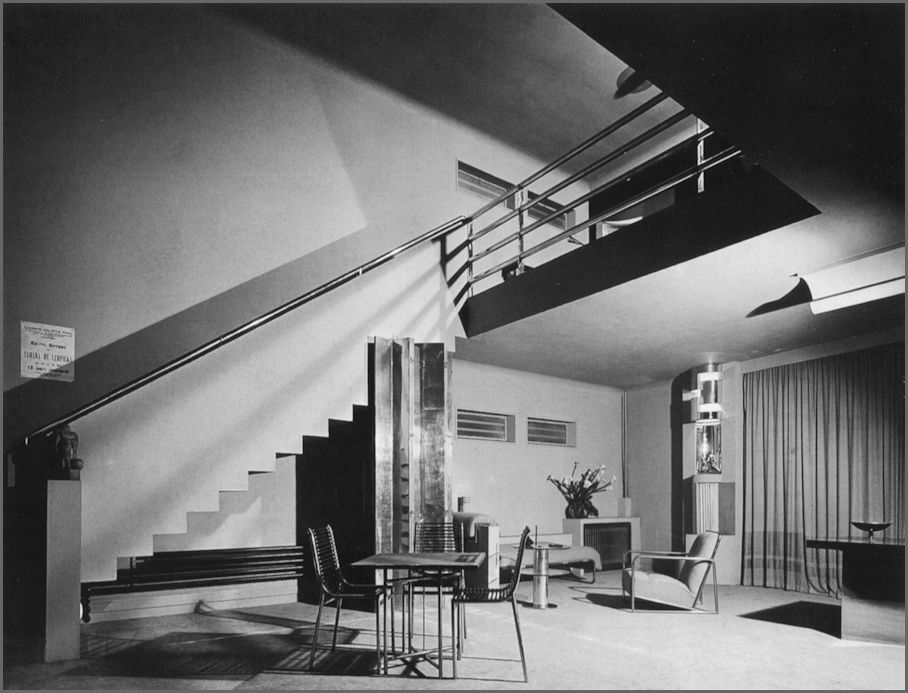
Detail of studio for Tamara de Lempicka showing staircase, bridge table and corner of the salon, in Mobilier et Décoration (January 1931). (uit: Un bel atelier moderne, bron: University of Warwick, foto: Gravot) - Source : atelierblog
History for Sale
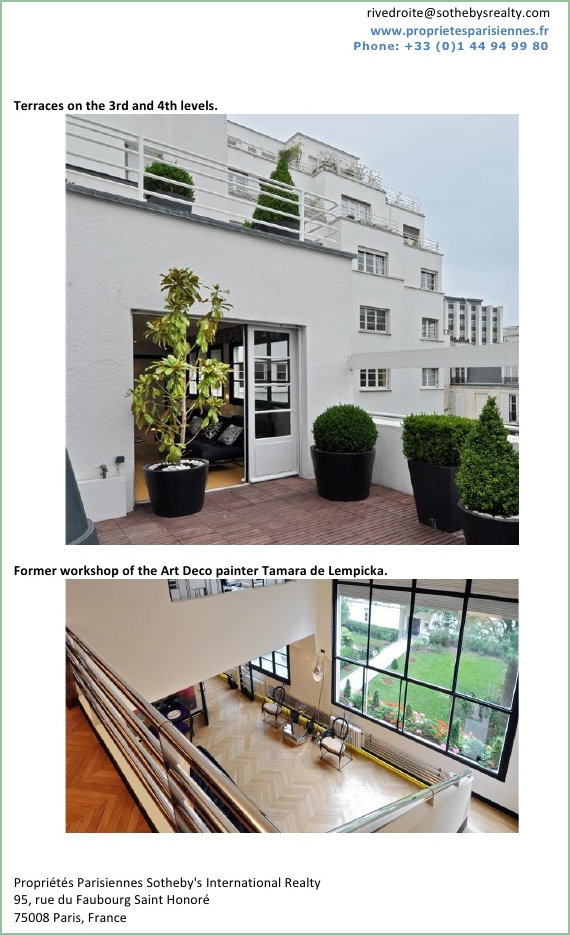
Luxury Apartment for Sale, Paris 14th Luxury Apartment Paris
This four-level living space was once the workshop of the Art Deco painter Tamara de Lempicka and is in a listed building built by Mallet-Stevens. The windows overlook the gardens of Cluny's Convent and the co-owners' gardens. The 248 sqm of living area include a 60 sqm workshop with 6 meter high ceiling, study, 3 bedrooms, a bathroom, and 3 shower rooms. There are two terraces on the 3rd and 4th levels that are 18 sqm and 22 sqm respectively. A four-level living space with 248 sqm. Source : slideshare.net
Vendors - Architecture de Collection
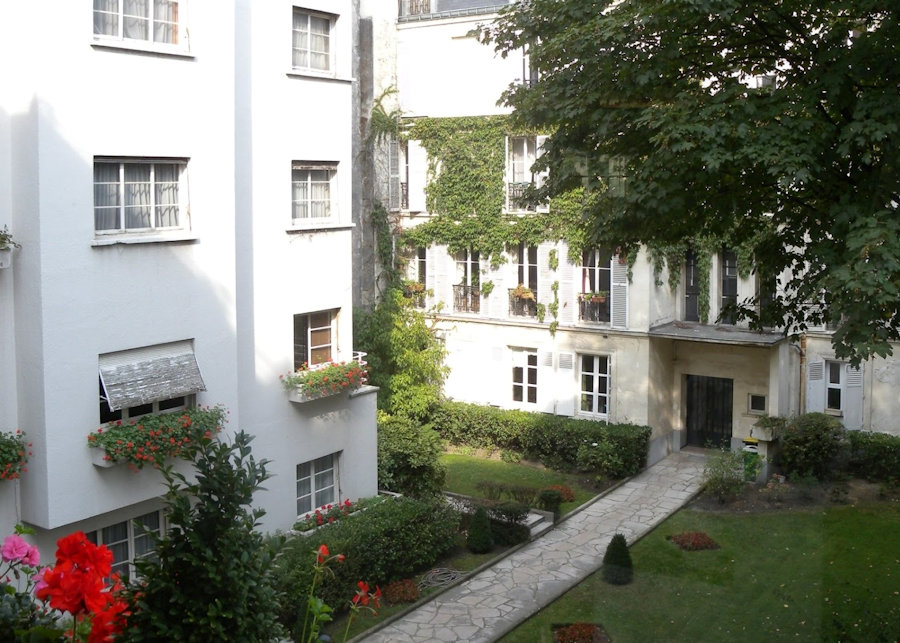
Exterior of the Robert Mallet-Stevens designed building housing Tamara de Lempicka's atelier
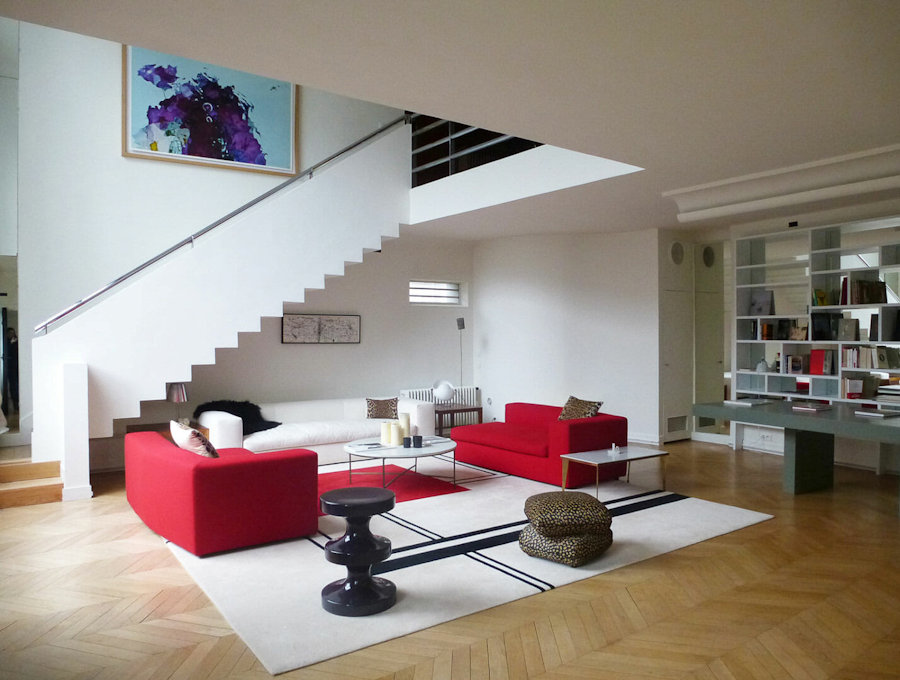
The Living area leading to the mezzanine floor
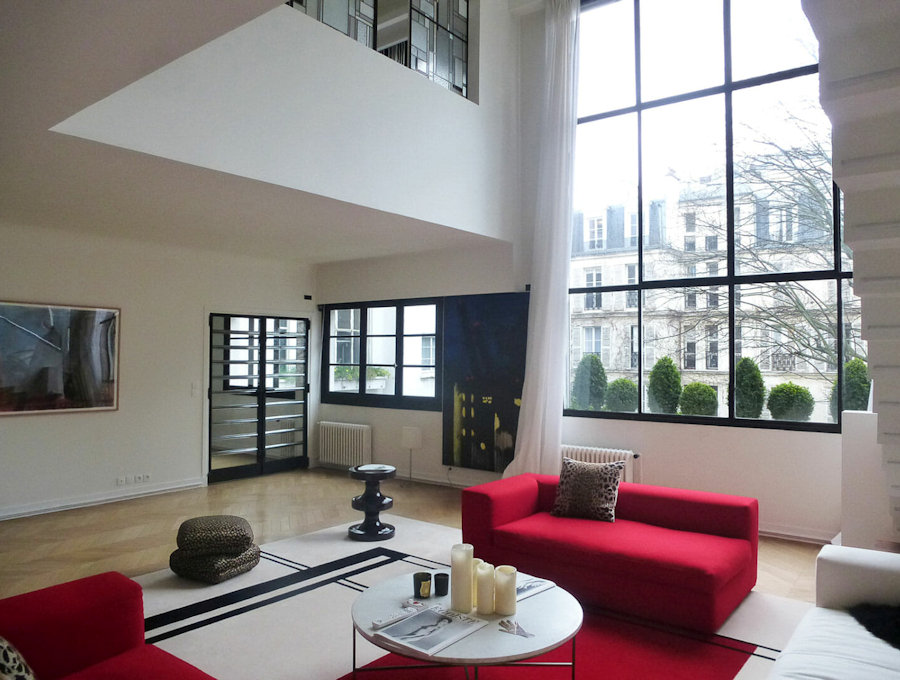
The Living area looking out on shared space
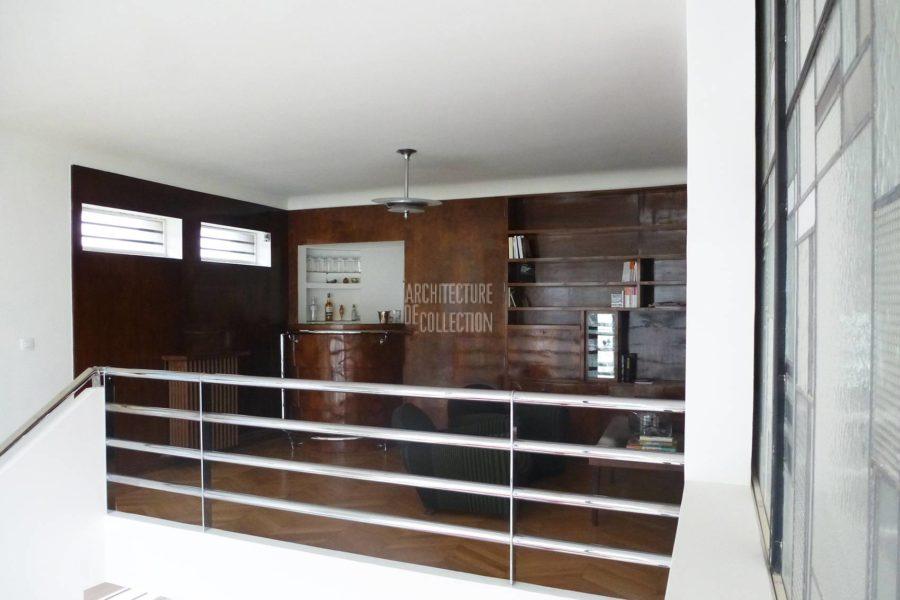
The mezzanine housing the bar area
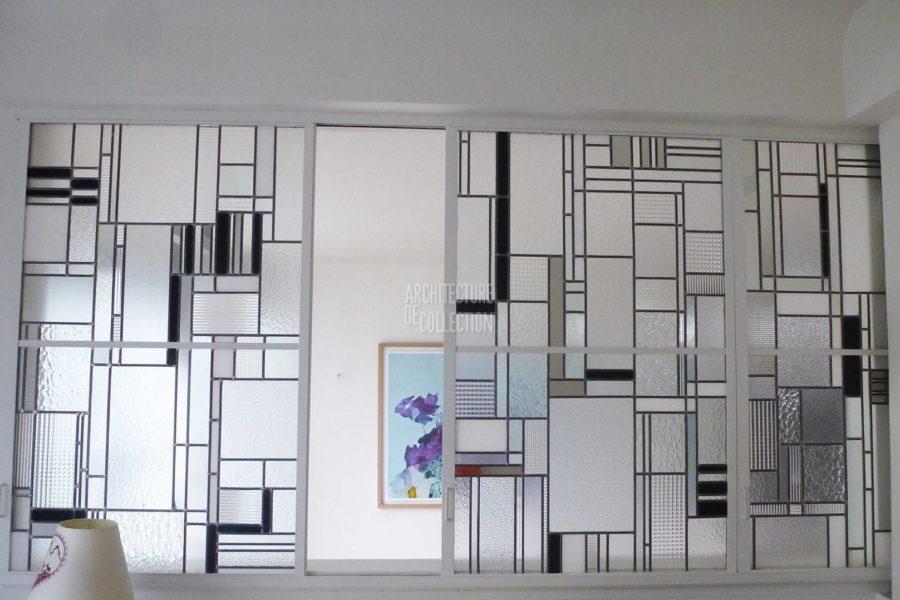
The frieze which can be seen from most living areas in the atelier
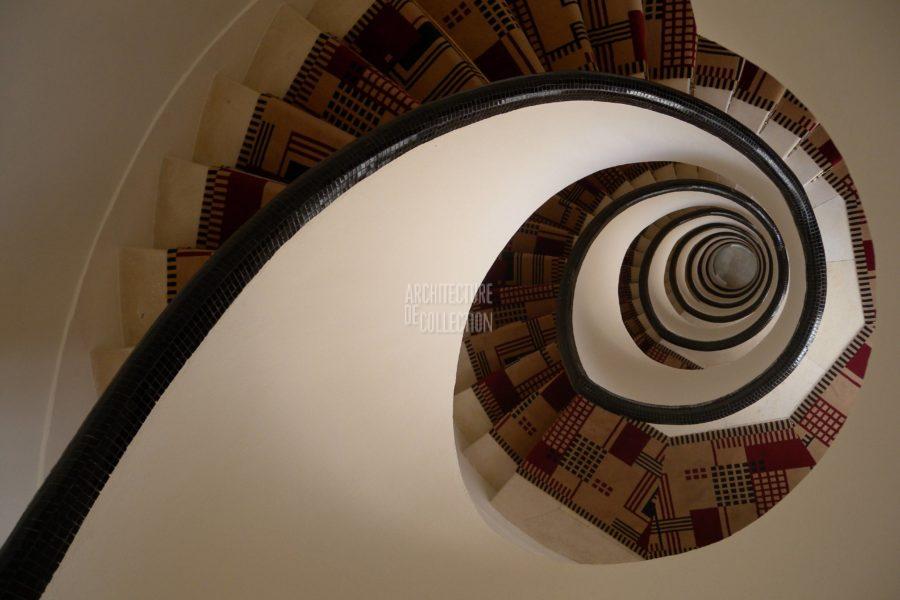
The magnificent stairwell and period carpeting
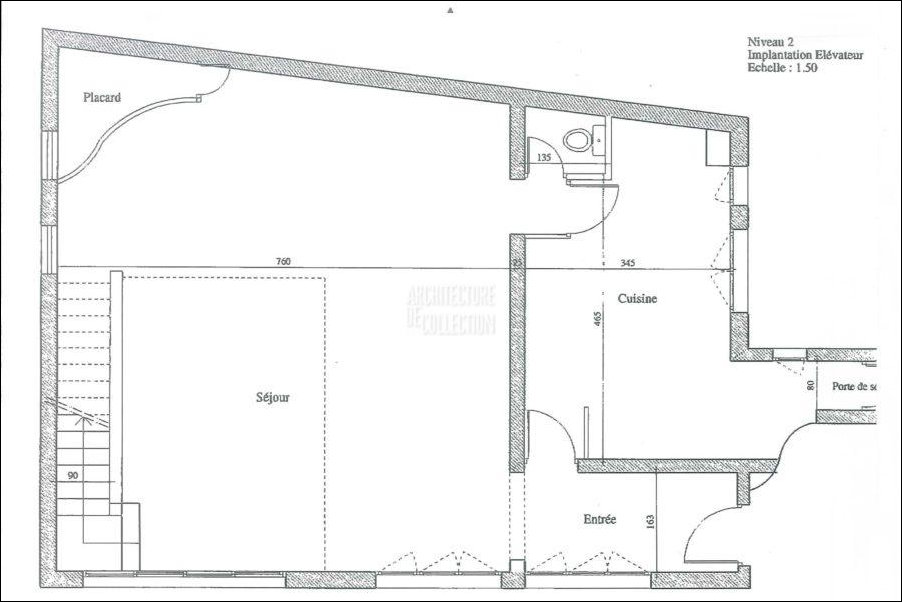
Ground plan of the living area
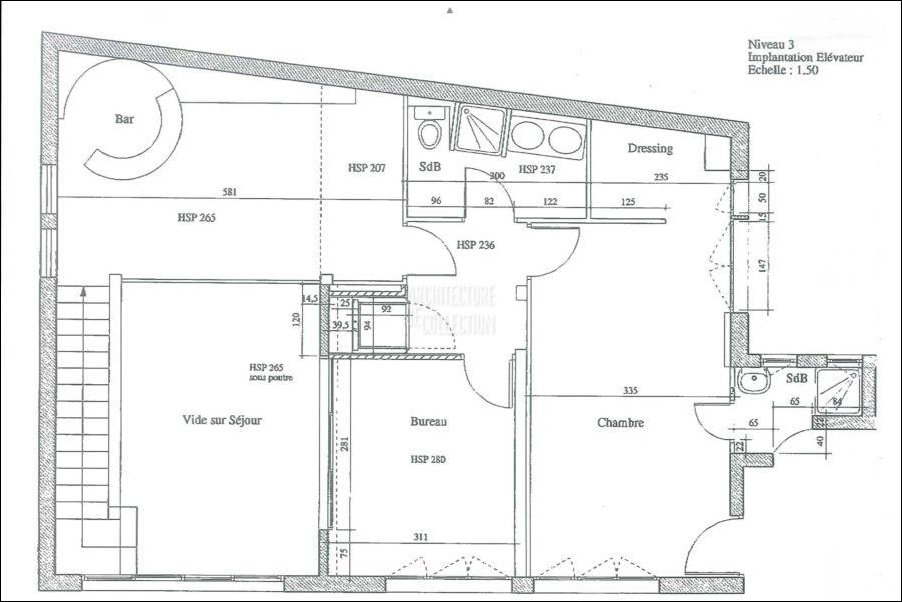
Groundplan identifying the bar area
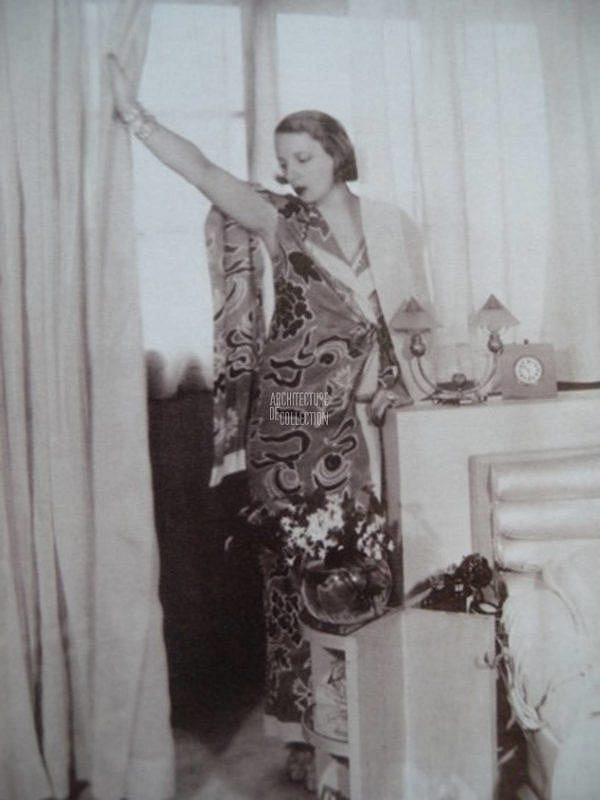
Tamara de Lempicka 'at home'
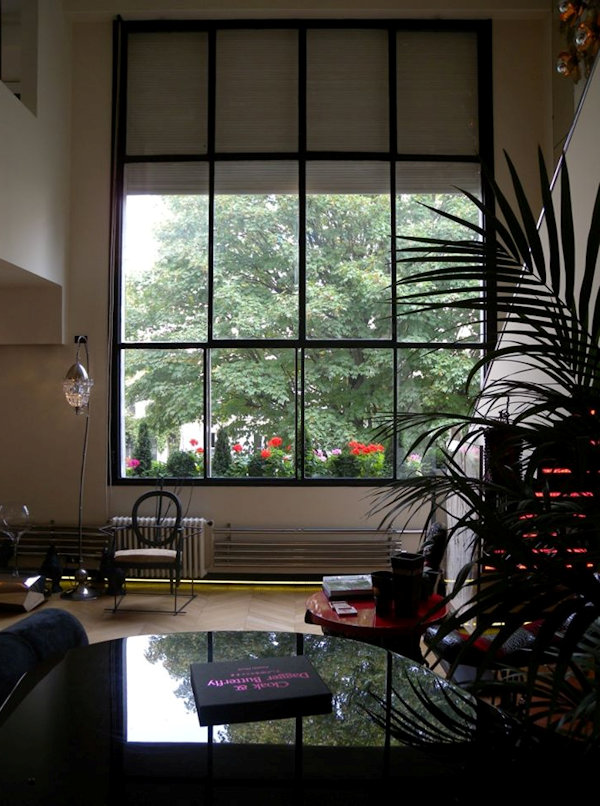
An atmospheric nook
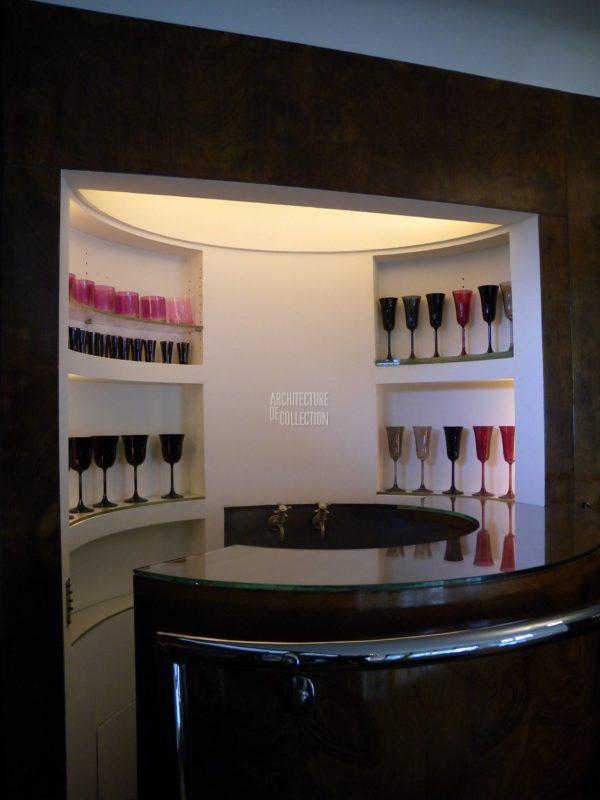
The actual bar
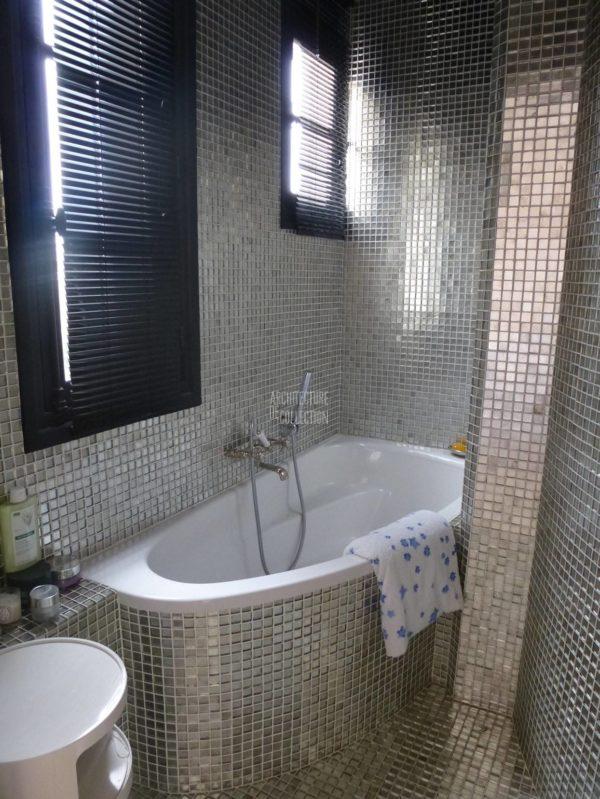
(Tiled) Bathroom
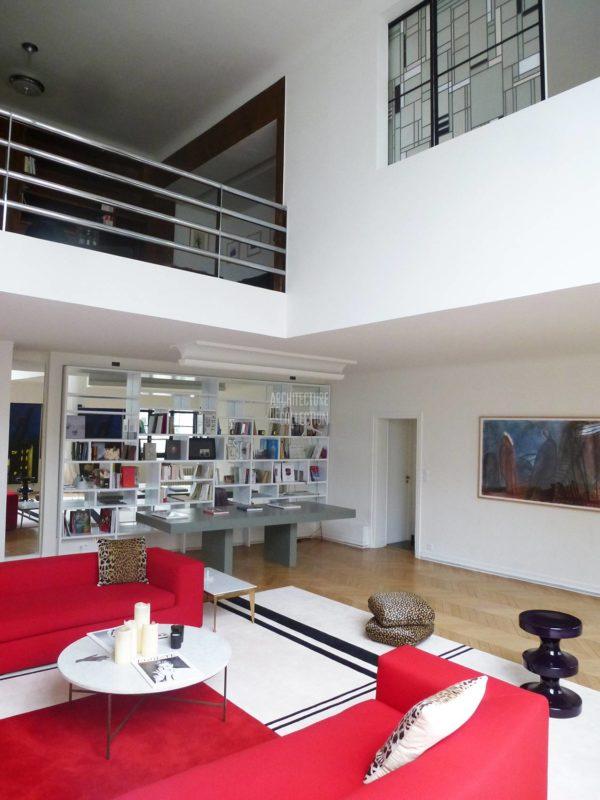
Living area showcasing the Frieze
All images shown below the 'Vendors' heading were sourced from and courtesy of architecturedecollection
An invaluable Art Deco testimony - This artist's studio, inhabited at the time by the famous painter Tamara de Lempicka, was the work of architect Robert Mallet-Stevens. The collaboration of Jean Prouvé, the Atelier Barillet and André Salomon in the construction of the building in which it takes place makes it a total work of art. Located in the 14th arrondissement of Paris, it overlooks the tree-lined courtyard of the condominium and the gardens of the Couvent des Sœurs de Cluny. Quiet, it offers many striking views. The 152 m² apartment is spread over two levels. It consists of a 60 m² workshop with 6 meters of height under ceiling, the decorative elements of which, like the stained glass windows made by Louis Barillet's workshop, have been preserved. The furniture in the smoking bar on the mezzanine is also original. The apartment also has a fully equipped kitchen, two bedrooms, a bathroom and a shower room. A cellar completes this exceptional property.
This workshop is located in the only apartment building built in Paris by Mallet-Stevens. The architect's inimitable style is clearly legible on the facade: cubic volumes, numerous recesses and smooth surfaces. Awnings, railings and window sills lighten the imposing expression of large areas of unrelieved structure. Particular care has been taken in the design of the entrances and in the common areas of the building. The staircase is very precious: over its entire height rises a stained glass composed of different laminated glasses with varied reliefs due to the master glassmaker Louis Barillet, the doors and joinery are in mahogany and the banister in Briare enamel .
Asking price: € 2,250,000. Fees charged to the seller. Co-ownership: N.C .. Average annual amount of the share of current expenses: 9,015 € / year. No procedure in progress. DPE: N.C. (Google translator app used with some adjustments)
More here
1928 - Stade Roland Garros
The facility was constructed in 1928 to host France's first defence of the Davis Cup. The stadium is named after Roland Garros, a French pioneer aviator who completed the first solo flight across the Mediterranean Sea, engineer (inventor of the first forward-firing aircraft machine gun), and World War I hero (as a pilot, he shot down four enemy aircraft, though popularly believed to be five). Garros was killed in aerial combat in October 1918.
History | Histoire (Arch) | Retro | RG | Art |
1923/1930 - Château de l'Horizon
At Maxine Elliott's chateau at Golfe Juan, French Riviera Distinguished guests enjoyed the hospitality at the luxury villa belonging to American actress Maxine Elliott at Golfe Juan on the French Riviera. The villa was designed by architect Barry Dierks and built at a cost of 80, 000. Among its features were shaded balconies and a water chute from the swimming pool out into the sea.
"Marilyn Monroe, Winston Churchill and Noël Coward are but a few of the storied guests who stayed at the various villas designed by Barry Dierks during the halcyon days of the French Riviera, yet few have ever heard of the Pittsburgh-born architect from the 1920s and ’30s. Unlike his contemporaries Eileen Gray and Robert Mallet-Stevens, who built the famous villa at Hyères, Dierks, a graduate of the École des Beaux-Arts in Paris, did not adhere to the classic Bauhaus style of the time. Instead, he developed a hybrid of American practicality wedded to European romanticism. One such masterpiece was Château de l’Horizon, which Dierks designed for American actress Maxine Elliott after she retired near Cannes. The grand structure was built on an impossible slip of land wedged between the railroad tracks and rocky shoreline. After two years of work, which included blasting the rocks to make a flat surface for a pool with a chute going down to the sea, the villa was completed in 1932. Elliott entertained in her new three-story home often, indulging her guests with every comfort." - Source : departures.com
"By 1920, Maxine's talent, and some help from her wealthy friends, had left her with no need for more money. She retired to a Mediterranean estate in Cannes, France. She wished to age gracefully at her home, Château de l'Horizon. A white art deco villa, it featured a large terrace and a long slide to drop her and her guests from the swimming pool into the sea. Large parties of libertines assembled at Maxine Elliott's French estate, and it became notorious. Winston Churchill visited from 1933 to 1939. During these years Churchill fell out of favor with the majority of Britons. He spent his time on the French Riviera, writing and plotting his return to power. Winston's wife Clementine had little use for Château de l'Horizon or Maxine and her friends. Clementine viewed them as gossipy and frivolous. Though perhaps her objections were more directly related to a single guest, Doris Castlerosse. It was at Château de l'Horizon that Winston and Doris would begin their affair. People have long known about Churchill's connection with Doris. In one letter to her he writes, "What fun we had at Maxine's. I wonder shall we meet again next summer." - Source : New England Historical Society
In 2018 Channel 4 featured an exposé episode bringing the Churchill/ Castlerosse affaire to the public eye - it even contains one scene where Churchill actually launches himself (head first) down the chute from the swimming pool where guests seemed to spend most of their time! An extract from the documentary-makers reads "This explosive one hour Secret History film reveals the story of Winston Churchill's secret affair, and how it came to haunt him. The story, uncovered by Exeter Professor of History Richard Toye and Warren Dockter, an international historian at Aberystwyth University, will forever cast Churchill in a new light." The Guardian Reviewer appears to be quite taken with the programme including commenting of Winston Churchill's swimming trunks .....
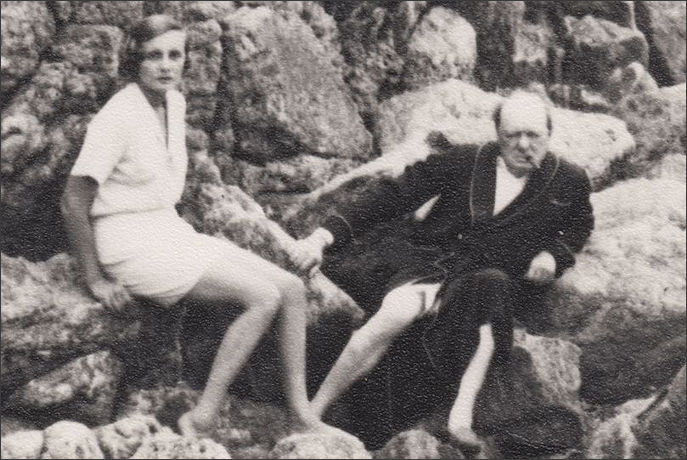
Churchill with lover Doris Castlerosse on a beach near Château de l'Horizon, southern France, in the mid 1930s (Image: Channel 4) - image sourced from The Mirror - during the programme a contemporary Delevigne, showing the images stresses the importance of Doris' signature white shorts which she wore to show of her long, lithe limbs!
From the Mirror "Sir Winston Churchill's secret four-year affair with Cara Delevigne's great aunt Lady Doris Castlerosse exposed. The war leader had a tryst with aristocrat Doris Castlerosse during the 1930s and aides feared he would be open to blackmail if anyone found out."
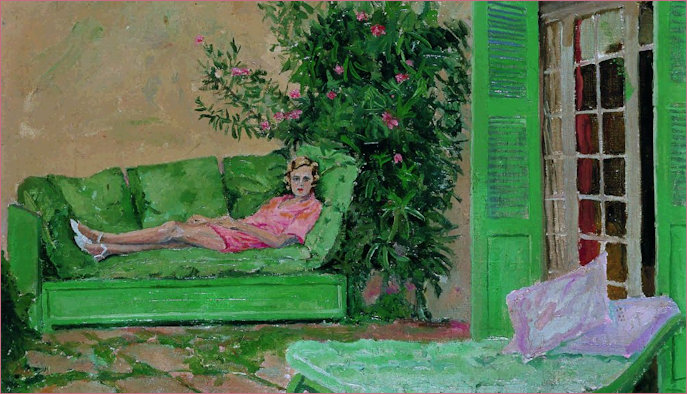
**Churchill's painting, "Viscountess Castlerosse on the Terrace at the Chateau de l'Horizon, 1933" (Coombs 158). The reader may judge just how "sultry" this is. (Churchill Heritage Ltd., reprinted by kind permission) - image and strapline sourced from richardlangworth.com with thanks
The Radio Times summarises the programme as "Documentary exploring the secret relationship between the prime minister and a woman he met in the South of France in the 1930s. During an important visit to President Roosevelt at the height of the war, he was reunited with his former lover, now stranded in the US and in possession of a portrait (see above**) that could have a devastating impact during a dangerous period for the nation."
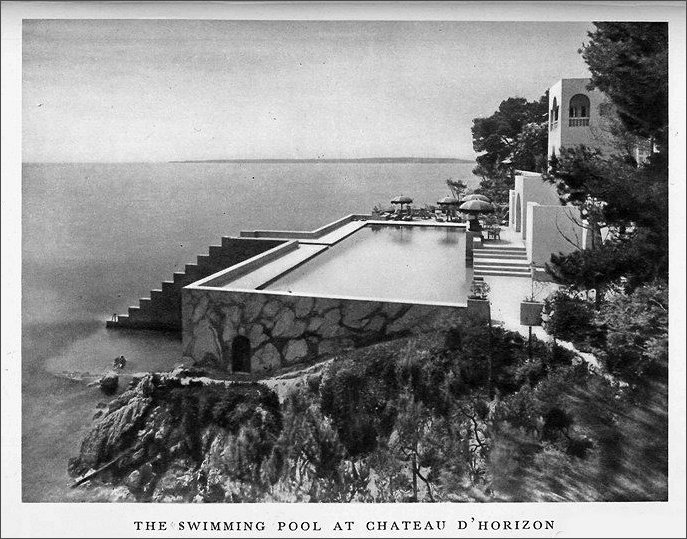
Image sourced from : NHDesignBlog
Sourced from Daily Mail article dated 23rd July 2015
This Château on the French Riviera Was Once a Playground for the Rich, Famous, and Royal
Château L'Horizon's jetset past was all but forgotten until recently.
By Ben Ryder Howe - 9th August 2017
Noël Coward and the Duke of Windsor were frequent visitors there, lounging by the pool. Winston Churchill wrote books and painted pictures of Doris Delevigne (Cara's great-aunt) there. The legendary Château de l'Horizon, on the French Riviera, was once known as the jewel of the Côte d'Azur and a magnet for the pre-jetset—and now it has its own biography, courtesy of Mary S. Lovell, author of acclaimed books on the Mitfords and the Churchills. Lovell's newest subject, though inanimate, proved as elusive as any of her others. Built in 1932, the elegantly proportioned white Art Deco villa on a majestic and secluded beach, with a swimming pool considered the best on the Riviera, is an architectural and historical landmark shrouded in secrecy and rumor—even more so since it was purchased by owners of considerably different taste, whose many redecorations and enlargements lay behind a 15-foot-tall fence topped with razor wire.
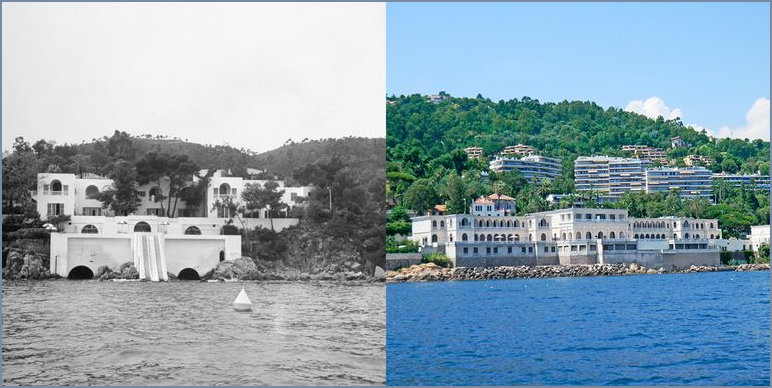
Images sourced from Town and Country - retro image on left courtesy and © of Getty Images / Life Magazine and Mary S. Lovell
In fact, the château's previous incarnation as a pleasure palace had been all but forgotten. When Lovell first attempted to reach the compound, her driver insisted she had the wrong address—the estate she said she wanted to visit "was the house of the Saudi king." Lovell was only able to establish that the Château de l'Horizon was, in fact, where she thought it was by photographing it from a chartered yacht. At first the "vast development painted pink and of no particular style" that she espied from the water looked nothing like the resort she had seen in pictures. "It took some dedicated examination back in my hotel room," Lovell says, to identify the once sleek villa under the bloated renovations of the House of Saud, which indeed bought the property 30 years ago. (The king rarely visits, favoring a property in Cannes, according to Lovell.) Nevertheless, this fall Lovell's book about the château, The Riviera Set, arrives in the U.S., conjuring a lost era of gin-soaked glamour in which the landmark's bed-hopping residents turned the Côte d'Azur into a year-round playground for the richest people on the planet.
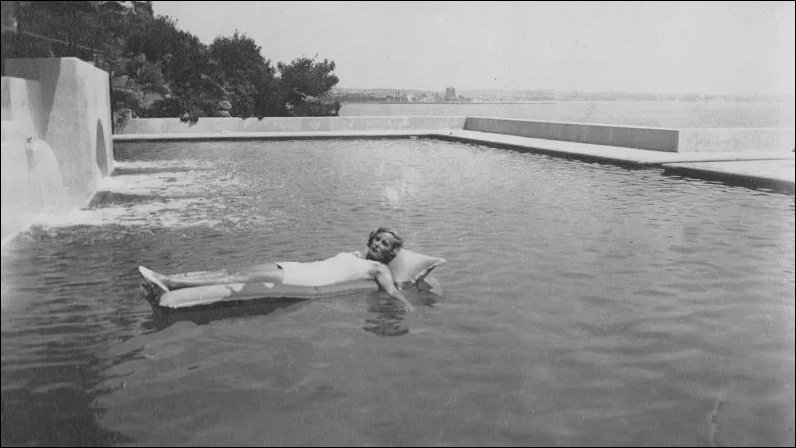
Doris Castlerosse taken at Chateau de L’Horizon, French Riviera mid 1930s - image sourced from Time.com
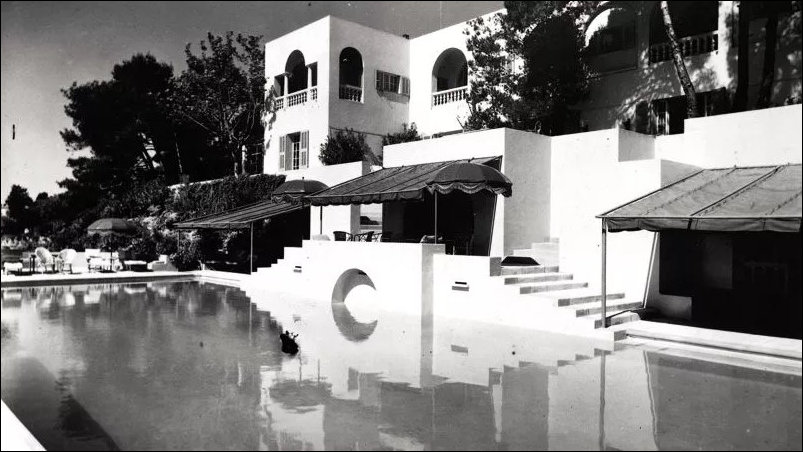
The Swimming Pool at the Château de l'Horizon - image sourced from le figaro
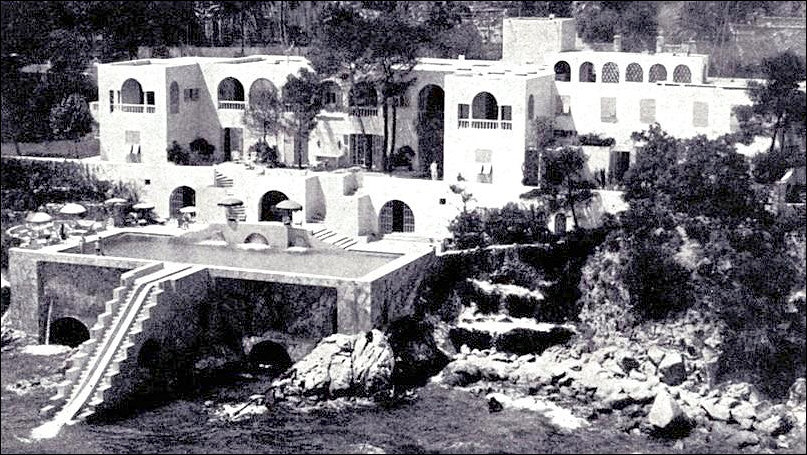
Front facade of the Château de l'Horizon - image sourced from Twitter
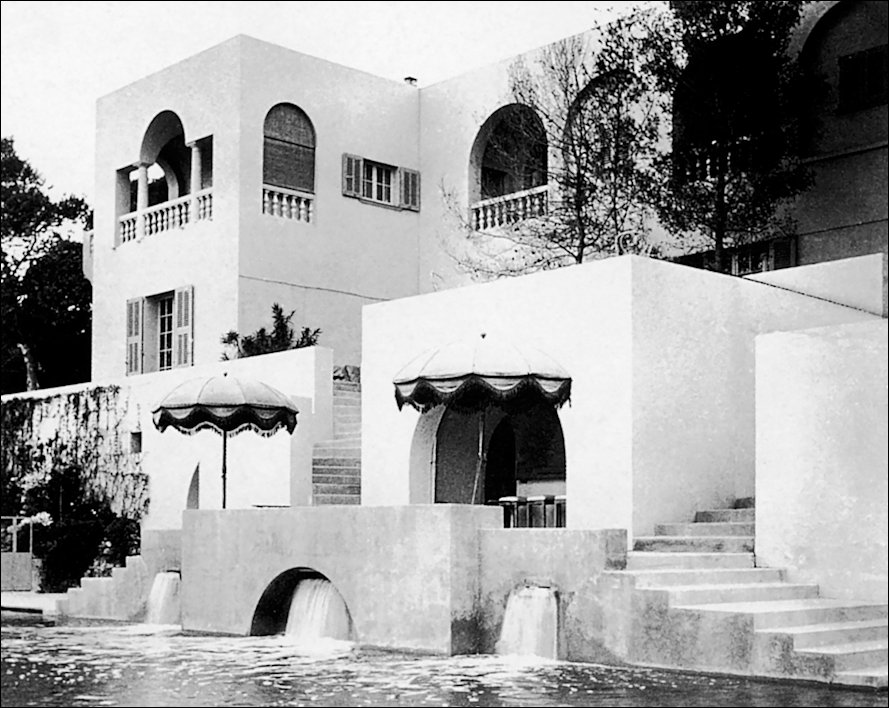
Swimming Pool entrance to the Château de l'Horizon - image sourced from the NY Times
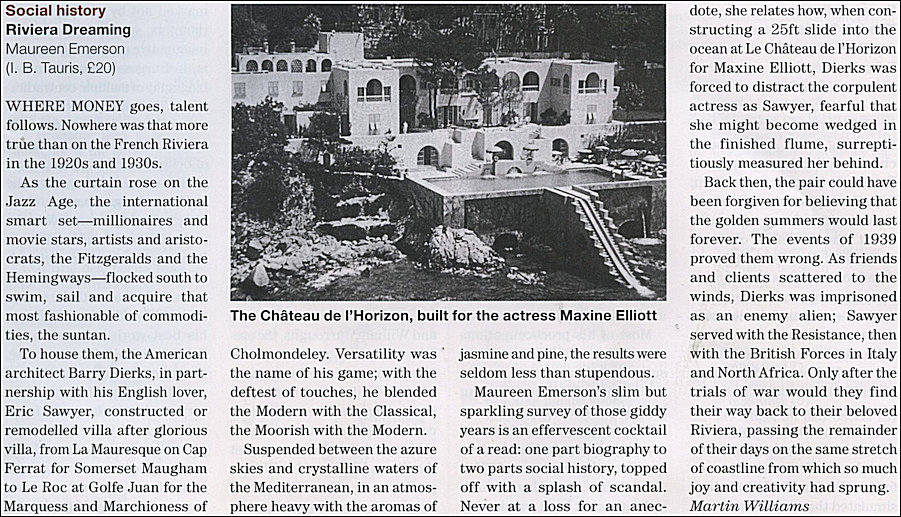
'Country Life Magazine' article and image sourced from rivieradreaming.co.uk

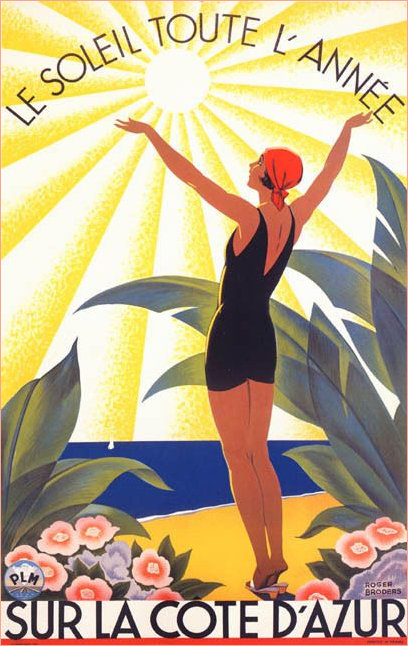
"In 1927, the song everyone was dancing to began: "I've danced with a man, who's danced with a girl, who's danced with the Prince of Wales." The Prince of Wales in question was, of course, the future Edward VIII, the man who went on to give up his country for the woman he loved, Wallis Simpson. The subject of Mary S Lovell's entertaining The Riviera Set is the Chateau de l'Horizon, a house on a rocky promontory between Cannes and Juan-les-Pins, which occupies a similarly tangential relationship to royal romance as the girl in the song. The white art deco house, built in 1932 by Barry Dierks for Maxine Elliott, an American showgirl turned Edwardian grande dame and possible royal mistress, was the backdrop to some of the most delicious nuggets of society gossip for 40 odd years. It was a house where Winston Churchill might have been seduced by Doris Castlerosse, where his daughter-in-law Pamela first found herself strangely attracted to the Italian multimillionaire Gianni Agnelli, and where Rita Hayworth was definitely seduced by Prince Aly Khan. The Côte d'Azur at the turn of the 20th century was where Russian aristocrats spent the winter. But after the First World War, when Coco Chanel stepped off the yacht of her lover the Duke of Westminster, sporting a tan, the South of France became a summer destination, a change famously documented in F Scott Fitzgerald's novel Tender is the Night, which drew on his time staying with Gerald and Sara Murphy, the American expatriates whose bohemian beach parties became a famous part of the Riviera scene." Source : The Times Review
Ces villas célèbres qui font le charme de la French Riviera
Un palais blanc posé sur les eaux.» C’est par ce nom très poétique que l’on désigne le château de l’Horizon, situé à Golfe Juan, et construit en 1923 pour la célèbre comédienne Maxine Eliott. Port privé, piscine de style art-déco agrémentée de toboggans qui se jettent directement dans les flots de la mer Méditerranée... Le décor de rêve est posé. La propriété a accueilli Winston Churchill, le prince Ali Khan et sa femme Rita Hayworth. Source : Le Figaro
Regrettably since changing ownership, this remarkable building is no longer accessible to the public.
Page refreshed : 10th August 2020 (G) (Still under construction)
